EXPOSING DEVELOPERS WHO FAIL TO APPRECIATE AND RESPECT COMMUNITY, ENVIRONMENT AND SPIRIT OF THE LAND
Yarra River
SILT KILLS NATIVE FISH!
For background on importance of Yarra River for freshwater fish click here.
New Yarra River Water Supply Maps Here and Here

July 25 2012: Amcor Suspected In Oil Leaks
June 17 2012: Pesticide Found Near Drinking Water Dam
November 22 2011: Yarra Future Rocky After Premier Drops Pledge To Make River Safe
November 21 2011: Not So Merri Reputation For Creek
November 14 2011: Mobil's Licence To Spill And Its Legal
Jan 28 2011: Yarra River Upstream of Sugarloaf Reservoir Contaminated With Pesticides
September 15 2009: Dights Falls Blocks Migrating Grayling
Replacement of Dight's Falls. This project was first mooted at least as far back as 2002. The concrete replacement is being put forward as heritage preservation as the old wooden structure has been listed by Heritage Victoria. The project began in October last year with a completion date set for Jun this year. It is still not complete. Melbourne Water said the didn't expect rain!

Late evening just before the big rain of Feb 4, 2011

February 5 2011, after heavy rain.

Dislodged rock and timber next to the flooded river diversion
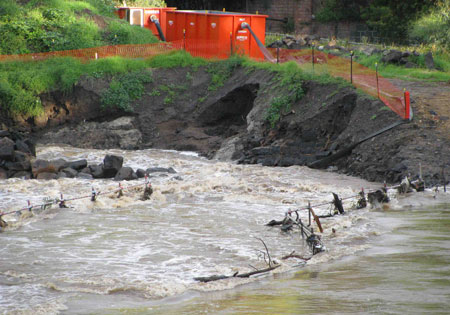
Erosion of west bank February 2011

June 2011, with rock beaching

Late evening just before the big rain of Feb 4, 2011
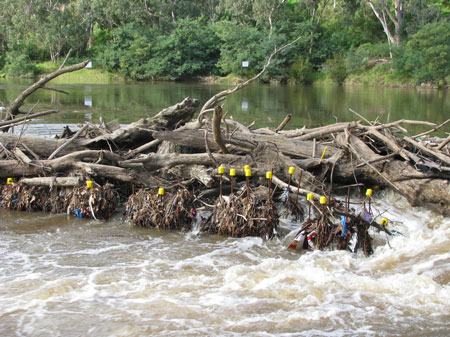
Timber washed against new piles
Trigger Values for Toxicants - (relating to above map)
Yarra Estuary (and CBD) threatened by Bay Dredging
Sugarloaf Reservoir and Olinda Creek page
Woori Yallock catchment and surrounds
Upper Yarra River & Gold Mining
In regards to the Upper Yarra, "DDT and its metabolites (TDE & DDE), Dieldrin, Lindane were detected in water samples at levels up to 0.04ug/L, 0.03ug/L and ) 0.05ug/L respectively. Whilst the maximum levels recorded were well below recommended maximum residues limits for pesticides in potable water supplies, they exceed ported threshold levels for the protection of aquatic organisms from chronic sublethal effects by as much as a factor of 40." Environmental Effects of Agricultural Land Use. Final Report to Liaison Committee - November 1982.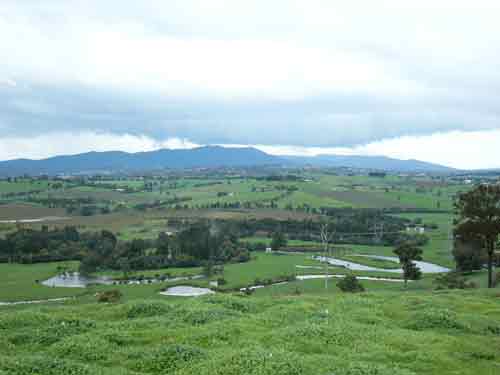
Sep 04: View showing natural floodplains near Henley floodplain located between Bend of Islands Gorge and Yering Gorge. This floodplain is being destroyed for a Golf Course Development. See Here. Dandenongs in background.

July 2007. Thousands of hectares of vineyards have been established in the Yarra valley in the past decade. Vineyards can rely on a number of toxic pesticides. Copper leaching into soil is another problem as is the toxic timber used to hold up vines. Toxic timber information can be found here.
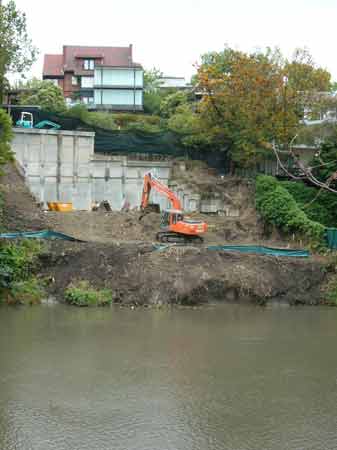
Nov 2007: Yarra bank caves in after work on Toorak home site

Sep 04: Downstream of Yering Gorge after heavy rains. Drinking water is s sourced from the Yarra River at Yering Gorge to supply Sugarloaf Reservoir.
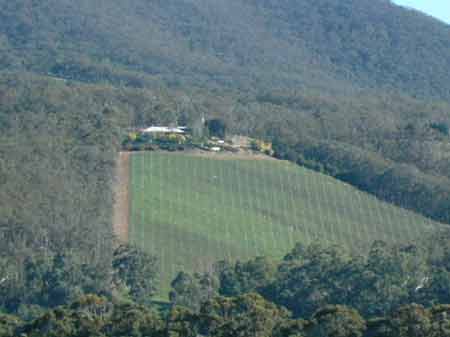
July 2007: More vineyards east of Warrambine hills
Groundwater in the Yarra Catchment
December 2003 Landslip (Lower Plenty).
Yarra River probe as man falls seriously ill. 7/1/05
Yarra Eel deaths heighten fears over pollution
Revealed Dangerous E.Coli makes a swimmable Yarra unachievable by 2008. 15/1/05
Let's make one thing perfectly clear 15/1/05
Dog poo blamed for river pollution 17/1/05
Warning plan on polluted Yarra 17/1/05
We need to give the Yarra another go The Age Editorial 18/1/05.
It's plain, Yarra's a stain in the rain, concedes Thwaites 19/1/05
The Yarra's not pristine - but we're working to get it there 19/1/05
Yarra watchdog axed to cut costs 20/1/05
Another river rower reveals illness 20/1/05
The Yarra's health is about more than just dog droppings 20/1/05
Exposed: Why the Yarra is so sick 22/1/05
The Kayaker Yarra water claims another victim 22/1/05
The Dog Walker - Pooper-scoopers are not the only solution 22/1/05
Yarra's a cesspool, tests show 5/3/05
Yarra's E coli levels soar 31/7/06
Confirmed: waste water on tap 25/9/06)
A little arsenic with your eel? Warning to limit intake of Yarra and Maribyrnong fish 24/1/07
Fill your glasses ... with the Yarra River 25/2/07
Mystery oil slick highlights sick Yarra 16/6/07
State Rivers Face Toxic Threat 16/9/07
Dead Fish Fear for Yarra 13/11/07
Dredging After Effects: Rivers Run Through it 18/11/07
Chemicals Threaten Yarra 21/11/ 07
Packaging Company forced to pay $100,000 for Yarra oil spill 12/12/07
Don't let Yarra River levels hit rock bottom 23/1/08
Catch of the Day Not For Eating 7/7/08
Yarra River's Poisonous Catch 27/10/08
It's Water That Suffers From a Full Metal Jacket 27/10/08
Yarra Merits Urgent Help 27/10/08
Yarra River Slowly Stagnates 28/10/08
Distressed Yarra Needs Our Love 28/10/08
River Rower Puts His Foot In It 28/10/08
Recycled Water Safe For Yarra 13/12/08
Rain Washes Rubbish Into Yarra 22/10/09
Yarra Bathers To Breathe Freely As Waste Drops to Save Levels 24/1/10
River Alert Fails To Halt Logging In Burnt Bush 6/2/10
Development Hots Up River Rivalry 16/4/10
Good Rains Mean 10 billion litre boost for Yarra 23/7/10
Sewage Reaches The Bay Again 13/4/11
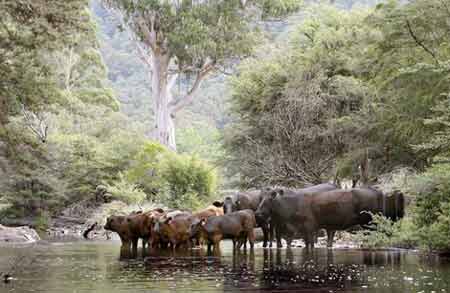
Cattle in the Yarra near Warburton. Photo Angela White. The Age

Erosion to Yarra river bank caused by cattle.
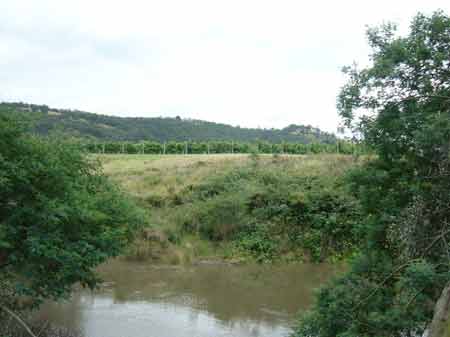
Vineyards in close proximity to Yarra River.
Groundwater in the Yarra Catchment
p14 "2.9 Hydrologic Relationships Between the Aquifers
Groundwater aquifers in the Yarra catchment should be recognised as temporary water storages. The Yarra River is a gaining stream, groundwater drains into the stream. This is the case with other perennial streams in the catchment.
Groundwater flow systems in the sense that they were first defined by Hubbert (1940), Toth (1963), and later elaborated by workers such as Freeze, Witherspoon and Meyboom exist within the fractured rocks of the area. It is probable that some interbasin groundwater flux exists between small sub catchments. However over in most of the area groundwater flow is probably accomodated by local and intermediate flow systems...
Leakage between aquifers and the weathered profiles resting on aquifers provides an important function in the migration of water in the Yarra Basin. The saprolitic mantles developed on the bedrock of the upper catchment provides very substantial storage for movement of groundwater into the deeper fractured rock settings and for discharge to the surface streams.
Recharge is generally achieved by infiltration of precipitation. Over the catchment recharge rates vary from less than 0.1% to over 10% of the total rainfall. The high rates of recharge occurs on the upper more elevated parts in the catchment. Groundwater discharge is achieved in the base of the valleys where the bedrock system outcrops and also from many of the spring zones located adjacent to the geological contacts. The springs are common at the contact between the New Volcanics or the Older Volcanics and the bedrock. Gully head springs are common in the upper catchments in the Newer Volcanics terrain. Change of slope springs occur in bedrock terrain and spring zones occur towards the base of alluvial fans shed from granitic landforms.
Groundwater in the bedrock siltstones and sandstones underlying the basalts and sub-basaltic sediments may be derived from either other areas by throughflow or vertical leakage from the overlying aquifers."
Source: Yarracare Groundwater in the Yarra Basin - Technical Document July 1995 (DCNR, MWC).
December 2003 Landslip (Lower Plenty).
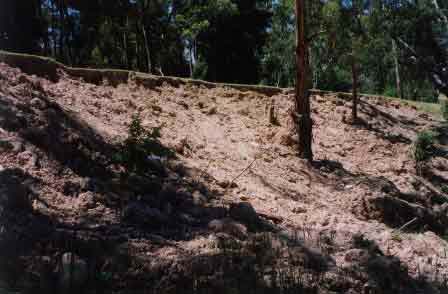
Dec 2003: Recent heavy rainfall in the Yarra River catchment has caused a massive landslip to occur near Eltham. Several hundred cubic metres of illegal fill and topsoil has been washed into the river. Melways Map 21 D12. The builder of a house above the slip area, illegally dumped many cubic metres of soil and 'fill' a few years ago so that he could extend his back lawn. This bad development has now given way leading to an extensive land slip threatening endangered fish species in the Yarra River immediately below and downstream of the slip area.
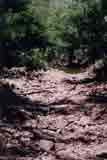 |
 |
 |
 |
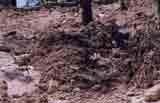 |
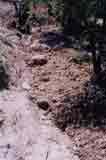 |
 |
December 2003: Landslip Images - courtesy Friends
of the Earth Melbourne.
|
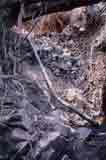 |

December 2003: This road concentrated landslip flow during the heavy downpour that dislodged the soil. The road is primarily used by Heidelberg Golf Club who pump water from the Yarra for their Golf Course.
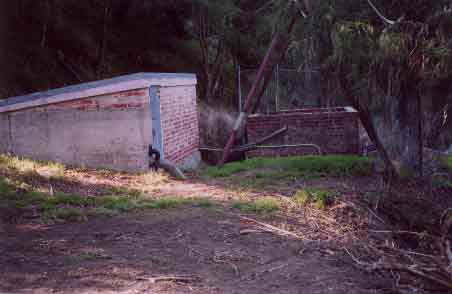
May 2004: Heidelberg Golf Course Pump House which lies at the bottom of the road near the Yarra River.
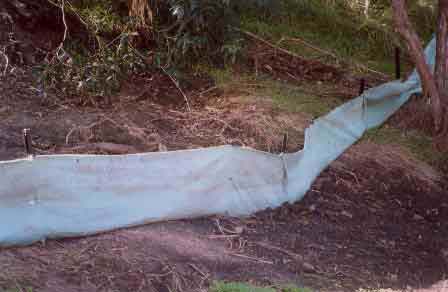
May 2004: Silt trap to apparently stop another mudslide from eventuating.

December 2003: Salt Creek - Heidelberg. Melways 32 B2. Recent siltation of drainage line near flat construction.
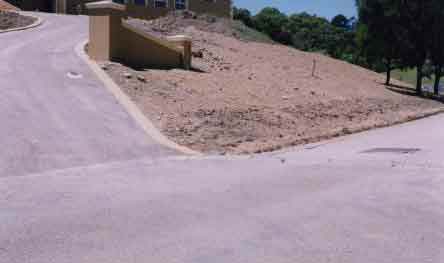
December 2003: Recent housing development with soil high erosion potential in Yarra catchment.
Table 3.4.1 Trigger vales for toxicants at alternative levels of protection. Values in pink text are the trigger values applying to typically slightly-moderately disturbed systems; see table 3.4.2 and Section 3.4.2.4 for guidance on applying these levels to different ecosystem conditions.
Trigger Values for freshwater (ugL-1)
Metals and Metalloids
| 99% | 95% | 90% | 80% | |
| Aluminium pH >6.5 | 27 | 55 | 80 | 150 |
| Aluminium pH <6.5 | ID | ID | ID | ID |
| Antimony | ID | ID | ID | ID |
| Arsenic (AsIII) | 1 | 24 | 94 c | 360 c |
| Arsenic (As V) | 0.8 | 13 | 42 | 140 c |
| Beryllium | ID | ID | ID | ID |
| Bismuth | ID | ID | ID | ID |
| Boron | 90 | 370 c | 680 c | 1300 c |
| Cadmium h | 0.06 | 0.2 | 0.4 | 0.8 c |
| Chromium (CrIII) h | ID | ID | ID | ID |
| Chromium (CrVI) | 0.01 | 1.0 c | 6 a | 40 a |
| Cobalt | ID | ID | ID | ID |
| Copper h | 1.0 | 1.4 | 1.8 c | 2.5 c |
| Gallium | ID | ID | ID | ID |
| Iron | ID | ID | ID | ID |
| Lanthanum | ID | ID | ID | ID |
| Lead h | 1.0 | 3.4 | 5.6 | 9.4 c |
| Manganese | 1200 | 1900 c | 2500 c | 3600 c |
| Mercury (inorganic) b | 0.06 | 0.6 | 1.9 c | 5.4 a |
| Mercury (methyl) | ID | ID | ID | ID |
| Molybdenum | ID | ID | ID | ID |
| Nickel h | 8 | 11 | 13 | 17 c |
| Selenium (Total) b | 5 | 11 | 18 | 34 |
| Selenium (SelV) b | ID | ID | ID | ID |
| Silver | 0.02 | 0.05 | 0.1 | 0.2 c |
| Thallium | ID | ID | ID | ID |
| Tin (inorganic, SnlV) | ID | ID | ID | ID |
| Tributyltin (as ug/L Sn) | ID | ID | ID | ID |
| Uranium | ID | ID | ID | ID |
| Vanadium | ID | ID | ID | ID |
| Zinc h | 2.4 | 8.0 c | 15 c | 31 c |
Non-Metallic Inorganics
| 99% | 95% | 90% | 80% | |
| Ammonia d | 320 | 900 c | 1430 c | 2300 a |
| Chlorine e | 0.4 | 3 | 6 a | 13 a |
| Cyanide f | 4 | 7 | 11 | 18 |
| Nitrate j | 17 | 700 | 3400 c | 17000 a |
| Hydrogen sulfide g | 0.5 | 1.0 | 1.5 | 2.6 |
Organic Alcohols
| 99% | 95% | 90% | 80% | |
| Ethanol | 400 | 1400 | 2400 c | 4000 c |
| Ethylene glycol | ID | ID | ID | ID |
| Isopropyl alcohol | ID | ID | ID | ID |
Chlorinated Alkanes
Chloromethanes
| 99% | 95% | 90% | 80% | |
| Dichloromethane | ID | ID | ID | ID |
| Chloroform | ID | ID | ID | ID |
| Carbon tetrachloride | ID | ID | ID | ID |
Chloroethanes
| 99% | 95% | 90% | 80% | |
| 1,2-dichloroethane | ID | ID | ID | ID |
| 1,1,1-trichloroethane | ID | ID | ID | ID |
| 1,1,2-trichloroethane | 5400 | 6500 | 7300 | 8400 |
| 1,1,2,2-tetrachloroethane | ID | ID | ID | ID |
| Pentachloroethane | ID | ID | ID | ID |
| Hexachloroethane b | 290 | 360 | 420 | 500 |
Chloropropanes
| 99% | 95% | 90% | 80% | |
| 1,1-dichloropropane | ID | ID | ID | ID |
| 1,2-dichloropropane | ID | ID | ID | ID |
| 1,3-dichloropropane | ID | ID | ID | ID |
Chlorinated Alkenes
| 99% | 95% | 90% | 80% | |
| Chloroethylene | ID | ID | ID | ID |
| 1,1-dichloroethylene | ID | ID | ID | ID |
| 1,1,2-trichloroethylene | ID | ID | ID | ID |
| 1,1,2,2-tetrachloroethylene | ID | ID | ID | ID |
| 3-chloropropene | ID | ID | ID | ID |
| 1,3-dichloropropene | ID | ID | ID | ID |
Anilines
| 99% | 95% | 90% | 80% | |
| Anline | 8 | 250 a | 1100 a | 4800 a |
| 2,4-dichloroaniline | 0.6 | 7 | 20 | 60 c |
| 2,5-dichloroaniline | ID |
ID
|
ID | ID |
| 3,4-dichloroaniline | 1.3 | 3 | 6 c | 13 c |
| 3,5-dichloroaniline | ID | ID | ID | ID |
| Benzidine | ID | ID | ID | ID |
| Dichlorobenzidine | ID | ID | ID | ID |
Aromatic Hydrocarbons
| 99% | 95% | 90% | 80% | |
| Benzene | 600 | 950 | 1300 | 2000 |
| Toluene | ID | ID | ID | ID |
| Ethylbenzene | ID | ID | ID | ID |
| o-xylene | 200 | 350 | 470 | 640 |
| m-xylene | ID | ID | ID | ID |
| p-xylene | 140 | 200 | 250 | 340 |
| m+p-xylene | ID | ID | ID | ID |
| Cumene | ID | ID | ID | ID |
Polycyclic Aromatic Hydrocarbons
| 99% | 95% | 90% | 80% | |
| Naphthalene | 2.5 | 16 | 37 | 85 |
| Anthracene b | ID | ID | ID | ID |
| Phenanthrene b | ID | ID | ID | ID |
| Fluoranthene b | ID | ID | ID | ID |
| Benzo(a)pyrene b | ID | ID | ID | ID |
Nitrobenzenes
| 99% | 95% | 90% | 80% | |
| Nitrobenzene | 230 | 550 | 820 | 1300 |
| 1,2-dinitrobenzene | ID | ID | ID | ID |
| 1,3-dinitrobenzene | ID | ID | ID | ID |
| 1,4-dinitrobenzene | ID | ID |
ID
|
ID |
| 1,3,5-trinitrobenzene | ID | ID | ID | ID |
| 1-methoxy-2-nitrobenzene | ID | ID | ID | ID |
| 1-methoxy-4-nitrobenzene | ID | ID | ID | ID |
| 1-chloro-2-nitrobenzene | ID | ID | ID | ID |
| 1-chloro-3-nitrobenzene | ID | ID | ID | ID |
| 1-chloro-4-nitrobenzene | ID | ID | ID | ID |
| 1-chloro-2,4-dinitrobenzene | ID | ID | ID | ID |
| 1,2-dichloro-3-nitrobenzene | ID | ID | ID | ID |
| 1,3-dichloro-5-nitrobenzene | ID | ID | ID | ID |
| 1,4-dichloro-2-nitrobenzene | ID | ID | ID | ID |
| 2,4-dichloro-2-nitrobenzene | ID | ID | ID | ID |
| 1,2,4,5-tetrachloro-3-nitrobenzene | ID | ID | ID | ID |
| 1,5-dichloro-2,4-dinitrobenzene | ID | ID | ID | ID |
| 1,3,5-trichloro-2,4-dinitrobenzene | ID | ID | ID | ID |
| 1-fluoro-4-nitrobenzene | ID | ID | ID | ID |
Nitrotoluenes
| 99% | 95% | 90% | 80% | |
| 2-nitrotoluene | ID | ID | ID | ID |
| 3-nitrotoluene | ID | ID | ID | ID |
| 4-nitrotoluene | ID | ID | ID | ID |
| 2,3-dinitrotoluene | ID | ID | ID | ID |
| 2,4-dinitrotoluene | 16 | 65 c | 130 c | 250 c |
| 2,4,6-trinitrotoluene | 100 | 140 | 160 | 210 |
| 1,2-dimethyl-3-nitrobenzene | ID | ID | ID | ID |
| 1,2-dimethyl-4-nitrobenzene | ID | ID | ID | ID |
| 4-chloro-3-nitrotoluene | ID | ID | ID | ID |
Chlorobenzenes and Chloronaphthalenes
| 99% | 95% | 90% | 80% | |
| Monochlorobenzene | ID | ID | ID | ID |
| 1,2-dichlorobenzene | 120 | 160 | 200 | 270 |
| 1,3-dichlorobenzene | 160 | 260 | 350 |
520 c
|
| 1,4-dichlorobenzene | 40 | 60 | 75 | 100 |
| 1,2,3-trichlorobenzene b | 3 | 10 | 16 | 30 c |
| 1,2,4-trichlorobenzene b | 85 | 170 c | 220 c | 300 c |
| 1,3,5-trichlorobenzene b | ID | ID | ID | ID |
| 1,2,3,4-tetrachlorobenzene b | ID | ID | ID | ID |
| 1,2,3,5-tetrachlorobenzene b | ID | ID | ID | ID |
| 1,2,4,5-tetrachlorobenzene b | ID | ID | ID | ID |
| Pentachlorobenzene b | ID | ID | ID | ID |
| Hexachlorobenzene b | ID | ID | ID | ID |
| 1-chloronaphthalene | ID | ID | ID | ID |
Polychlorinated Biphenyls (PCBs) & Dioxins
| 99% | 95% | 90% | 80% | |
| Capacitor 21 b | ID | ID | ID | ID |
| Aroclor 1016 b | ID | ID | ID | ID |
| Aroclor 1221 b | ID | ID | ID | ID |
| Aroclor 1232 b | ID | ID | ID | ID |
| Aroclor 1242 b | 0.3 | 0.6 | 1.0 | 1.7 |
| Aroclor 1248 b | ID | ID | ID | ID |
| Aroclor 1254 b | 0.01 | 0.03 | 0.07 | 0.2 |
| Aroclor 1260 b | ID | ID | ID | ID |
| Aroclor 1262 b | ID | ID | ID | ID |
| Aroclor 1268 b | ID | ID | ID | ID |
| 2,3,4'-trichlorobiphenyl b | ID | ID | ID | ID |
| 4,4'-dichlorobiphenyl b | ID | ID | ID | ID |
| 2,2',4,5,5'-pentachloro-1,1'biphenyl b | ID | ID | ID | ID |
| 2,4,6,2',4,6'-hexachlorobiphenyl b | ID | ID | ID | ID |
| Total PCBs b | ID | ID | ID | ID |
| 2,3,7,8-TCDD b | ID | ID | ID | ID |
Phenols and Xylenols
| 99% | 95% | 90% | 80% | |
| Phenol | 85 | 320 | 600 | 1200 c |
| 2,4-dimethylphenol | ID | ID | ID | ID |
| Nonylphenol | ID | ID | ID | ID |
| 2-chlorophenol t | 340 c | 490 c | 630 c | 870 c |
| 3-chlorophenol t | ID | ID | ID | ID |
| 4-chlorophenol t | 160 | 220 | 280 c | 360 c |
| 2,3-dichlorophenol t | ID | ID | ID | ID |
| 2,4-dichlorophenol t | 120 | 160 c | 200 c | 270 c |
| 2,5-dichlorophenol t | ID | ID | ID | ID |
| 2,6-dichlorophenol t | ID | ID | ID | ID |
| 3,4-dichlorophenol t | ID | ID | ID | ID |
| 3,5-dichlorophenol t | ID | ID | ID | ID |
| 2,3,4-trichlorophenol t | ID | ID | ID | ID |
| 2,3,5-trichlorophenol t | ID | ID | ID | ID |
| 2,3,6-trichlorophenol t | ID | ID | ID | ID |
| 2,4,5-trichlorophenol t,b | ID | ID | ID | ID |
| 2,4,6-trichlorophenol t,b | 3 | 20 | 40 | 95 |
| 2,3,4,5-tetrachlorophenol t,b | ID | ID | ID | ID |
| 2,3,4,6-tetrachlorophenol t,b | 10 | 20 | 25 | 30 |
| 2,3,5,6-tetrachlorophenol t,b | ID | ID | ID | ID |
| Pentachlorophenol t,b | 3.6 | 10 | 17 | 27 a |
Nitrophenols
| 99% | 95% | 90% | 80% | |
| 2-nitrophenol | ID | ID | ID | ID |
| 3-nitrophenol | ID | ID | ID | ID |
| 4-nitrophenol | ID | ID | ID | ID |
| 2,4-dinitrophenol | 13 | 45 | 80 | 140 |
| 2,4,6-trinitrophenol | ID | ID | ID | ID |
Organic Sulphur Compounds
| 99% | 95% | 90% | 80% | |
| Carbon disulfide | ID | ID | ID | ID |
| Isopropyl disulfide | ID | ID | ID | ID |
| n-propyl sulfide | ID | ID | ID | ID |
| Propyl disulfide | ID | ID | ID | ID |
| Tert-butyl sulfide | ID | ID | ID | ID |
| Phenyl disulfide | ID | ID | ID | ID |
| Bis(dimethylthiocarbamyl)sulfide | ID | ID | ID | ID |
| Bis(diethylthiocarbamyl)disulfide | ID | ID | ID | ID |
| 2-methoxy-4H-1,3,2-benzodioxaphosphorium-2-sulfide | ID | ID | ID | ID |
Xanthates
| 99% | 95% | 90% | 80% | |
| Potassium amyl xanthate | ID | ID | ID | ID |
| Potassium ethyl xanthate | ID | ID | ID | ID |
| Potassium hexyl xanthate | ID | ID | ID | ID |
| Potassium isopropyl xanthate | ID | ID | ID | ID |
| Sodium ethyl xanthate | ID | ID | ID | ID |
| Sodium isobutyl xanthate | ID | ID | ID | ID |
| Sodium isopropyl xanthate | ID | ID | ID | ID |
| Sodium sec-butyl xanthate | ID | ID | ID | ID |
Phthalates
| 99% | 95% | 90% | 80% | |
| Dimethylphthalate | 3000 | 3700 | 4300 | 5100 |
| Diethylphthalate | 900 | 1000 | 1100 | 1300 |
| Dibutylphthalate b | 9.9 | 26 | 40.2 | 64.6 |
| Di(2-ethylhexyl)phthalate b | ID | ID | ID | ID |
Miscellaneous Industrial Chemicals
| 99% | 95% | 90% | 80% | |
| Acetonitrile | ID | ID | ID | ID |
| Acrylonitrile | ID | ID | ID | ID |
| Poly(acrylonitrile-co-butadiene-co-styrene) | 200 | 530 | 800 c | 1200 c |
| Dimethylformamide | ID | ID | ID | ID |
| 1,2-diphenylhydrazine | ID | ID | ID | ID |
| Diphenylnitrosamine | ID | ID | ID | ID |
| Hexachlorobutadiene | ID | ID | ID | ID |
| Hexachlorocyclopentadiene | ID | ID | ID | ID |
| Isophorone | ID | ID | ID | ID |
Organochlorine Pesticides
| 99% | 95% | 90% | 80% | |
| Aldrin b | ID | ID | ID | ID |
| Chlordane b | 0.03 | 0.08 | 0.14 | 0.27 c |
| DDE b | ID | ID | ID | ID |
| DDT b | 0.006 | 0.01 | 0.02 | 0.04 |
| Dicofol b | ID | ID | ID | ID |
| Dieldrin b | ID | ID | ID | ID |
| Endosulfan b | 0.03 | 0.2 a | 0.6 a | 1.8 a |
| Endosulfan alpha b | ID | ID | ID | ID |
| Endosulfan beta b | ID | ID | ID | ID |
| Endrin b | 0.01 | 0.02 | 0.04 c | 0.06 a |
| Heptachlor b | 0.01 | 0.09 | 0.25 | 0.7 a |
| Lindane | 0.07 | 0.2 | 0.4 | 1.0 a |
| Methoxychlor b | ID | ID | ID | ID |
| Mirex b | ID | ID | ID | ID |
| Toxaphene b | 0.1 | 0.2 | 0.3 | 0.5 |
Organophosphorus Pesticides
| 99% | 95% | 90% | 80% | |
| Azinphos methyl | 0.01 | 0.02 | 0.05 | 0.11 a |
| Chlorpyrifos b | 0.00004 | 0.01 | 0.11 a | 1.2 a |
| Demeton | ID | ID | ID | ID |
| Demeton-S-methyl | ID | ID | ID | ID |
| Diazinon | 0.00003 | 0.01 | 0.2 a | 2 a |
| Dimethoate | 0.1 | 0.15 | 0.2 | 0.3 |
| Fenitrothion | 0.1 | 0.2 | 0.3 | 0.4 |
| Malathion | 0.002 | 0.05 | 0.2 | 1.1 a |
| Parathion | 0.0007 | 0.004 c | 0.01 c | 0.04 a |
| Profenofos b | ID | ID | ID | ID |
| Temephos b | ID | ID | ID | ID |
Carbamate & Other Pesticides
| 99% | 95% | 90% | 80% | |
| Carbofuran | 0.06 | 1.2 a | 4 a | 15 a |
| Methomyl | 0.5 | 3.5 | 9.5 | 23 |
| S-methoprene | ID | ID | ID | ID |
Pyrethroids
| 99% | 95% | 90% | 80% | |
| Deltamethrin | ID | ID | ID | ID |
| Esfenvalerate | ID | 0.001* | ID | ID |
Herbicides & Fungicides
Bypyridilium herbicides
| 99% | 95% | 90% | 80% | |
| Diquat | 0.01 | 1.4 | 10 | 80 a |
| Paraquat | ID | ID | ID | ID |
Phenoxyacetic acid herbicides
| 99% | 95% | 90% | 80% | |
| MCPA | ID | ID | ID | ID |
| 2,4-D | 140 | 280 | 450 | 830 |
| 2,4,5-T | 3 | 36 | 100 | 290 a |
Sulfonylurea herbicides
| 99% | 95% | 90% | 80% | |
| Bensulfuron | ID | ID | ID | ID |
| Metsulfuron | ID | ID | ID | ID |
Thiocarbamate herbicides
| 99% | 95% | 90% | 80% | |
| Molinate | 0.1 | 3.4 | 14 | 57 |
| Thiobencarb | 1 | 2.8 | 4.6 | 8 c |
| Thiram | 0.01 | 0.2 | 0.8 c | 3 a |
Triazine herbicides
| 99% | 95% | 90% | 80% | |
| Amitrole | ID | ID | ID | ID |
| Atrazine | 0.7 | 13 | 45 c | 150 c |
| Hexazinone | ID | ID | ID | ID |
| Simazine | 0.2 | 3.2 | 11 | 35 |
Urea herbicides
| 99% | 95% | 90% | 80% | |
| Diuron | ID | ID | ID | ID |
| Tebuthiuron | 0.02 | 2.2 | 20 | 160 c |
Miscellaneous herbicides
| 99% | 95% | 90% | 80% | |
| Acrolein | ID | ID | ID | ID |
| Bromacil | ID | ID | ID | ID |
| Glyphosate | 370 | 1200 | 2000 | 3600 a |
| Imazethapyr | ID | ID | ID | ID |
| Ioxynil | ID | ID | ID | ID |
| Metolachlor | ID | ID | ID | ID |
| Sethoxydim | ID | ID | ID | ID |
| Trifluralin b | 2.6 | 4.4 | 6 | 9 a |
Generic Groups of Chemicals
Surfactants
| 99% | 95% | 90% | 80% | |
| Linear alkylbenzene sulfonates (LAS) | 65 | 280 | 520 c | 1000 c |
| Alcohol ethoxyolated sulfate (AES) | 340 | 650 | 850 c | 1100 c |
| Alcohol ethoxylated surfactants (AE) | 50 | 140 | 220 | 360 c |
| Oils & Petroleum Hydrocarbons | ID | ID | ID | ID |
Oil Spill Dispersants
| 99% | 95% | 90% | 80% | |
| BP 1100X | ID | ID | ID | ID |
| Corexit 7664 | ID | ID | ID | ID |
| Corexit 8667 | ID | ID | ID | |
| Corexit 9527 | ID | ID | ID | ID |
| Corexit 9550 | ID | ID | ID | ID |
* = High reliability figure for esfenvalerate derived from mesocosm NOEC data (no alternative protection levels available)
a = Figure may not protect key test species from acute toxicity (and chronic) - check Section 8.3.7 for spread of data and its significance. 'a' indicates that trigger value > acute toxicity figure; note that trigger value should be <1/3 of acute figure (Section 8.3.4.4).
b = Chemicals for which possible bioaccumulation and secondary poisoning effects should be considered (see Sections 8.3.3.4 and 8.3.5.7).
c = Figure may not prtect key test species from chronic toxicity (this refers to experimental chronic figures or geometric mean for species) - check Section 8.3.7 for spread of data and its significance. Where grey shading and 'c' coincide, refer to text in Section 8.3.7.
d = Ammonia as TOTAL ammonia as [NH3-N] at pH 8. For changes in trigger value with pH refer to Section 8.3.7.2.
e = Chlorine as total chlorine, as [Cl]; see Section 8.3.7.2
f = Cyanide as un-ionised HCN, measured as [S]; section 8.3.7.2.
g = Sulfide as un-ionised H2S, measured as [S]; see section 8.3.7.2.
h = Chemicals for which algorithms have been provided in table 3.4.3 to account for the effects of hardness. The vales have been calculated using a hardness of 30 mg/L CaCO3. These should be adjusted to the site-specific hardness (see Section 3.4.3).
j = Figures protect against toxicity and do not relate to eutrophication issues. Refer to section 3.3 if eutrophication is the issue of concern.
ID = Insufficient data to derive a reliable trigger value. Users advised to check if a low reliability value or an ECL is given in section 8.3.7.
t = Tainting or flavour impairment of fish flesh may possibly occur at concentrations below the trigger value. See sections
{1}

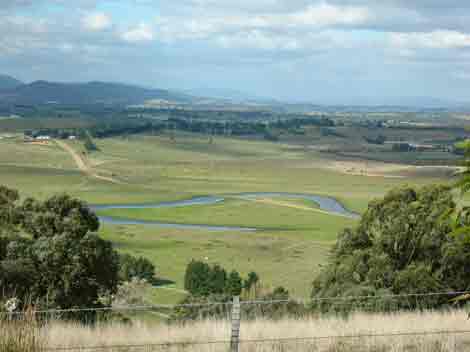
May 05: Same billabong about 7 months later.

Henley Billabongs

Henley Flood Plain. River at 2.5 m at Yering Gorge.
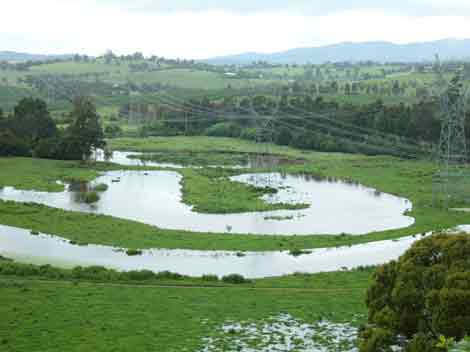
Henley Flood Plain
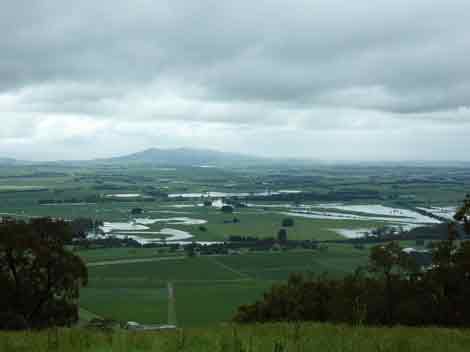
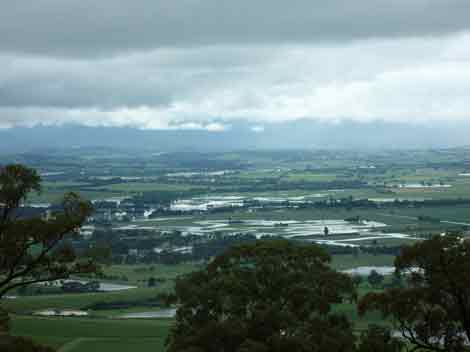
Yarra floodplain near Yarra Glen
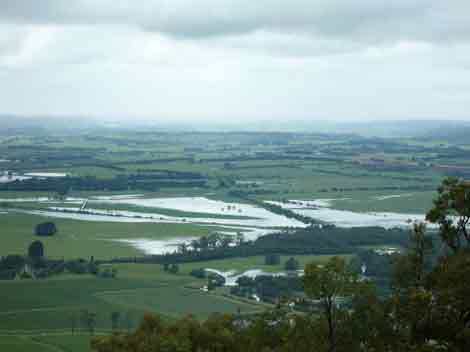

Backed up water upstream of Yering Gorge.

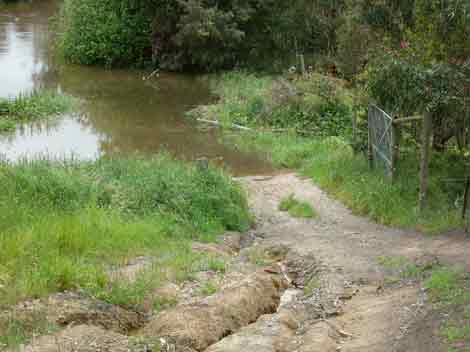
Poor erosion hazard from local road.

Engorged Yarra River at Bend of Islands
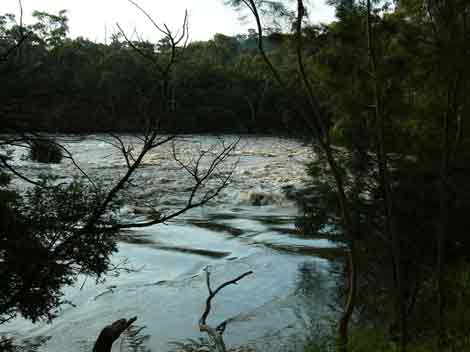
Engorged Yarra River at Bend of Islands
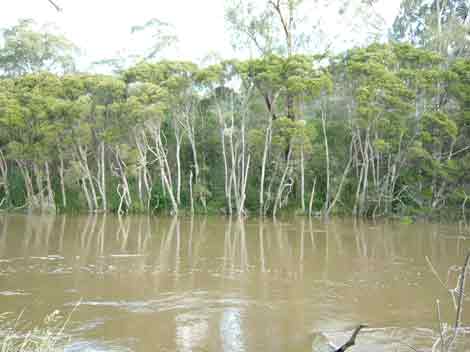
Engorged Yarra River at Bend of Islands. Swamp Paperbark.
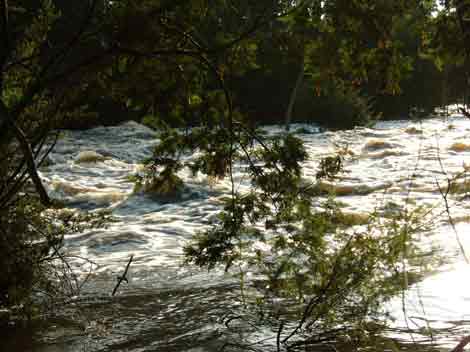
Engorged Yarra River at Bend of Islands

Nov 15, 2004: Diamond Creek in flood.

Nov 15, 2004: Diamond Creek in flood.

November 15, 2004: Diamond Creek in flood.

November 15, 2004: Diamond Creek meets the Yarra River.
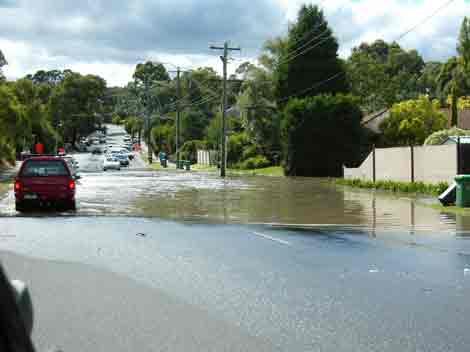
Feb 3 05: Flooding near Amaroo Crt Diamond Creek after record rains.
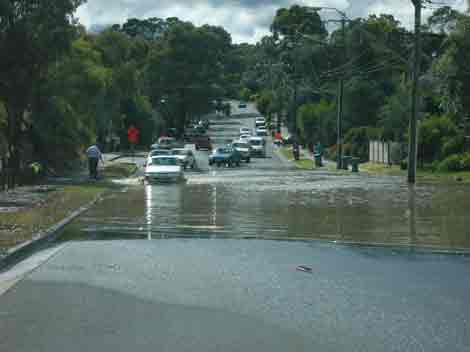
Feb 3 05: Flooding near Amaroo Crt Diamond Creek after record rains.

Feb 3 2005: Flooding of Diamond Creek at Wilson Reserve, Wattle Glen

Feb 3 2005: Flooding of Diamond Creek at Wilson Reserve, Wattle Glen
Yarra River probe as man falls seriously ill.
By Kenneth Nguyen The Age 7/1/05 p7
The Yarra Riverís bacteria-riddled urban stretch is under scrutiny after a man who accidenlty swallowed its water suffered lung haemorrhaging and kidney failure.
Mark Shorter 28, spent 14 days under sedation in intensive care after tumbling into the water while kayaking.
He also suffered liver failure, bouts of delusion and severe jaundice - symptoms which St Vincentís Hospital doctors attribute to the leptospira strain of bacteria.
The Department of Human Services is investigating whether the Coburg man contracted leptospirosis from the Yarra.
A department spokesman said the source of the leptospirosis had not yet been identified.
St Vincentís infectious diseases registrar Dr Craig Aboltins said it was likely that the riverís water was to blame.
Mr Shorter, now recovering at home, says he went kayaking near Dights Falls, Collingwood, on November 6 last year.
Rain the previous day had brought with it quicker rapids - but also the possibility of increased stormwater pollution.
Mr Shorter fell in the river and took in water through his nose. "I would have had my moth shut because we know the waterís pretty horrible," he said.
Flu-like symptoms gave way two weeks later to more worrying problems, including jaundice - "I was basically the colour of a banana", Mr Shorter says - and vomiting.
He went to the emergency department at St Vincentís, where he fainted and was admitted to intensive care with liver and kidney failure and lung haemorrhaging.
"I also started to get a bit delusional," Mr Shorter says. "I was thinking all these crazy things, that the nurses were conspiring to keep me there, that I didnít need my oxygen mask."
Mr Shorter is now in rehabilitation, hoping to recover the 10 kilograms he lost while ill.
Dr Aboltins said Mr Shorter was unlucky to suffer such severe symptoms.
Leptospirosis is more commonly contracted in rural communities. Infections are caused by contact with the urine of infected cattle, pigs, horses, dogs, rodents and wild animals.
Doctors remain unsure whether the symptoms were the result of Mr Shorterís own physiology or a particular strong strain of the bacteria.
In 2003-04, about 85 per cent of samples taken in the Yarra Riverís urban stretch failed the public health targets in relation to E.coli contamination.
Mr Shorter said: "The health of the river, close to the city, is pretty crook, pretty neglected, and has the potential to inflict illnesses upon us."
The Government aims to have the Yarra River safe for activities such as swimming by 2008.
The Department says it has not yet found any evidence of a public health risk.
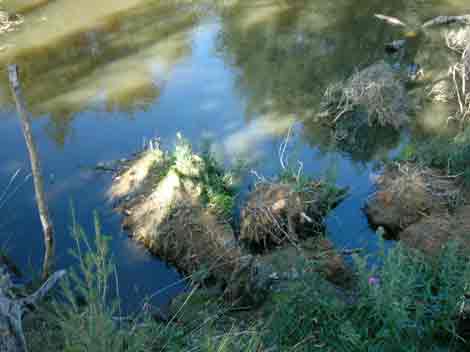
May 05: Collapasing river bank near Henley flood plain.
Yarra Eel deaths heighten fears over pollution
By Farrah Tomazin State Political Reporter The Age 14/1/05 p3
The Environment Protection Authority is investigating the deaths of dozens of eels found floating in the Yarra River, prompting further concerns about pollution in the riverís urban stretch.
Up to 60 eels were found floating yesterday from the Richmond Rail Bridge to Dights Falls in Clifton Hill.
The Age found several eels washed up around a boat ramp outside the Xavier and Hawthorn rowing clubs. Others were later found upstream near Barkers Road.
Rowers had earlier made the bizarre discovery, which came after revelations three kayakers had suffered lung haemorrhaging, kidney failure and delusions after using the bacteria-riddled river in the past three years. One victim, Mark Shorter, 28, contracted leptospirosis - found in the urine of infected animals - after accidentally swallowing water while kayaking at Dights Falls last November. A second victim, Mathew Dixon, contracted the illness in 2002 after performing an Eskimo-roll manoeuvre in the river while kayaking near Warrandyte.
The State Government has maintained that the Yarra does not pose a public health risk.
But Opposition environment spokesman Phil Honeywood said Victorians had the right to feel safe in the river, and called on the Government to allow an independent analysis of its water quality.
Those who use the Yarra regularly also expressed concerns. "If something has the ability to kill eels, it must be pretty potent," said Hawthorn Rowing Club member Frances Courtney, who says she has seen "at least 16" dead eels.
Another member, Ian Jackson , agreed. He said he had seen about 20 dead eels, and that the smell around the river had intensified in the past few days. "Iíve been rowing regularly for about 15 years and Iíve never smelt anything like this," he said.
The EPA is investigating. "While we are hopeful of determining a possible cause for the death of these eels, it appears unlikely, as it seems the eels have been dead for a number of days, which makes investigation all the more difficult," said EPA chairman Mick Bourke.
Authorities say fish deaths tend to occur during the summer months, when warmer weather often triggers changes in water environments. Melbourne Water officers will remove the eels.
Acting Premier John Thwaites said the Government - which wants to make the Yarra safe for swimming by 2008 - had allocated $8 million to improve the river this year.
The Age p1 January 15, 2005 Revealed Dangerous E.Coli makes a swimmable Yarra unachievable by 2008.
Bacteria-riddled river 22 times over safe level Canoeistsí illness spreads alarm By Stephen Cauchi Science Reporter
Bacteria levels in the Yarra River, the presumed source of a spate of illnesses in kayakers, were more than 20 times the minimum safe level at times during 2004, The Age has found. Melbourne Waterís monthly figures for waterway bacteria Ė not publicly available Ė cast serious doubt on the State Government's goal of having the Yarra suitable for swimming by 2008.
The only monitoring station on the lower Yarra - stretching from the Chandler Highway in Kew to the river's mouth at Port Phillip Bay - shows that average levels of E.coli in 2004 were 542, well above the Environment Protection Authority's safe swimming level of 200.
But the average masks enourmous surges in E.coli regularly measured by the monitoring station, at Princes Bridge. In November, E.coli levels were 4400 - 22 times the EPA minimum for safe swimming. The September figure was 2700 - more than 13 times the safe level. The February figure was 1500.
E.coli bacteria can cause gastroenteritis. Other bacteria in the river, including leptospira and salmonella, are not measured by Melbourne Water, but high levels of E.coli indicate high levels of these too.
This week The Age revealed that three kayakers have suffered lung haemorrhaging, kidney failure and delusions after using the bacteria-riddled river in the past three years.
On Thursday 60 eels were found dead on the Yarra downstream from Dights Falls. Environment Minister John Thwaites said yesterday: "There is no evidence the river is unsafe." The Department of Human Services, which is investigating the eel deaths, shares this view.
The Yarra's bacteria come from animal faeces and urine, washing in from upstream pastures and through gutters and drains. Run-off from unsewered properties and sewage overflow is another bacterial source.
Melbourne Water technology general manager Peter Scott said there had been "significant improvements" in the health of Melbourne's waterways over the past 20 years, but "it's going to take a while before we can achieve all of the EPA objectives". "There's obviously a very large number of micro-organisms that can cause illness and it would be too costly and impractical to monitor them all," he said. "We use E.coli as an indicator because it's representative of fecal contamination."
Individual bacterial counts in the Yarra are usually not released. In January 1991, the Liberal opposition released data showing that counts were 42 times the EPA minimum.
Last November kayaker Mark Shorter, 28, contracted leptospirosis - found in infected animal's urine - after accidently swallowing water at Dights Falls in Collingwood. In 2002 kayaker Mathew Dixon contracted the same illness near Warrandyte.
Yet according to the testing station in that suburb, this stretch of the Yarra had an average E.coli count of just 120 in 2003-04. The river's other stations measured averages of 170 at Kew, 180 at Coldstream and Healesville, 220 at Launching Place and 100 at Millgrove.
In many of Melbourne's other rivers and creeks the "base rate" of E.coli and other bacteria is well above EPA desired levels. When there is heavy rain, the base rate rises "over tenfold" and the EPA warns against swimming for five days after the rain.
Average E.coli counts in 2003-04 for Merri Creek and Moonee Ponds Creek were 380 and 550; for Gardiner's Creek and Koonung Creek, Bulleen, 810 and 1800. But the EPA standard for these creeks is 1000, as the standard is not set for swimming.
The Maribyrnong River's count at Keilor and Avondale Heights, measured using a median average, was 120 and 150. For water to be suitable for swimming, the EPA median must be 150.
Asked about the Government's goal to make the Yarra safe for swimming by 2008, Mr Scott said: "The Yarra, because its got this very long, winding path through the urban area - and just the density of population - it's going to be very challenging." He said bacterial levels in the river after a rainstorm increased by "a factor of 10 or greater".
The EPA director of water and national programs, Chris Bell, said the goals for the Yarra were "pretty ambitious". "It's a very difficult problem . . . you know what's on your street outside. It'll end up in the Yarra," he said.
Environment Victoria executive director Marcus Godinho said diverting water upstream was hurting the river. "Because we've taken so mush water out of the Yarra, we don't get the Yarra flushing out all of the nasties," he said.
E.coli counts Average number of organisms per 100ml: 2003/2004
| Merri Creek | 380 |
| Moonee Ponds Creek | 550 |
| Gardiners Creek | 810 |
| Koonung Creek | 1800 |
EPA standard for these creeks is 1000 as they are not meant for swimming.
| Maribyrnong River (Keilor) | 120 |
| Maribyrnong River (Avondale Heights) | 150 |
These rivers measured using a median. EPA median must be 150 for swimming in these areas.
Let's make one thing perfectly clear (The Age p2 15/1/05) Stephen Cauchi
Twenty-five years ago The Age began its famous "Give the Yarra a Go" campaign. One of its six key planks was very simple: clean up the river. But the campaign has fallen short, certainly in the lower reaches.
The Yarra, like many of Melbourne's waterways, is dirty and diseased. Despite the progress since 1980, it may well be another 25 years before it is safe to swim in.
Of course, cleaning up the Yarra, as with any long urban river, is a big and costly challenge. Every time there is a rainstorm, the river is flushed with dog waste, litter and pollutants from gutters and creeks.
Upstream, urine and faeces from sheep and other other animals is washed in. There are still unsewered properties along its length, and sewerage pipes can overflow.
But that has not stopped politicians from making absurd claims. During the original Age campaign, journalist John Larkin reflected how, in 1972, conservation minister Bill Borthwick had forecast that by 1980 people would be swimming happily under Princes Bridge. In 1984, the Cain government announced a $200 million plan to clean up the Yarra. The then planning and environment minister, Evan Walker, said people should be able to swim "very safely" in river's lower regions by 1989.
But in January 1991, the Liberal opposition released data showing E.coli counts 42 times the minimum safe level. EPA chairman Brian Robinson's response? The 1984 policy was overly ambitious, he told The Age. "To lay down a standard that that particular part of the river could meet within that time was more than just ambitious," he said. "It would take a lot of money and time to make it safe for swimming, if that could be achieved at all."
In 2002, Dr Robinson retired from the EPA. He told The Age the "softly softly" approach had failed and "a bit of two-by-four" was needed, including threats of prosecution to force authorities to make the lower Yarra safe for swimming by 2008.
Current Government policy is to get 85 per cent of Melbourne's waterways up to scratch by 2008, the rest by 2030. Peter Scott, of Melbourne Water, told The Age this week that meeting the 2008 deadline would be, to put it mildly, "a challenge". What about the 2030 target? Who knows? Fifty years after the original campaign, people may finally be swimming under Princes Bridge.
Dog poo blamed for river pollution By Bianca Wordley The Australian 17/1/05
Dog poo is being blamed for e-coli in Melbourne's waterway, the Yarra River.
The Victorian Government, which has come under fire for the dirty state of the river after 100 eels were found dead, said more people needed to be aware that not picking up after their dog could be contributing to the problem. "There can be up to 90 tonnes of dog poo that's washed down into the river system and then into the bay, and that's the principal cause of e-coli into the river," Environment Minister John Thwaites said today.
"All of us need to do more to reduce litter. "That's why we are talking about a major public education change so that people understand that whatever they drop in the street could end up in the river and that leads to pollution." Mr Thwaites said while dog excrement was one of the major causes of e-coli in the river, decaying organic matter such as dead birds and trees also could add to the problem. He said e-coli levels were higher in parts of the river that run through the city.
In suburban areas, the bacteria levels were low enough for people to safely swim, he said. Attention was drawn to the quality of the river's water after 100m-long eels were found dead in the Yarra last week. The Environment Protection Authority (EPA) said it appeared the eels might have been killed by a virus, bacteria or toxicant several weeks ago and washed downstream to the Clifton Hill and Richmond area in inner Melbourne. Mr Thwaites said it appeared the eels' death was not linked to water quality but further investigation was needed to be sure.
Nonetheless, the State Government would ask the EPA to look at the possibility of establishing an e-coli early warning system, similar to that already in place in Port Phillip Bay, in a bid to tackle the pollution problem. "In the case of the (Yarra) river, I will seek advice from the EPA whether we should have a system for the river like we have for Port Phillip Bay which will warn people of high e-coli levels," he said.
He said the State Government had applied to the National Water Commission for extra federal funding for a range of water programs, including storm water management. "Victoria's done what we can, but we are still waiting to hear from the federal government," he said.
At the weekend, state Opposition environment spokesman Phil Honeywood accussed the Government of hiding the truth about the river's pollution levels. "There's a cover-up going on," Mr Honeywood said, after the dead eels were discovered. "Until we know what's going on with this river we need to have more regular (testing), regular updates on water quality testing and then we need to have the government putting in the funding to ensure we know where the problem is coming from."
E-coli infection is caused by one of the hundreds of strains of the Escherichia coli bacterium. Although most strains are harmless and live in the intestines of healthy humans and animals, this strain produces a powerful toxin and can cause severe illness and death.
Warning plan on polluted Yarra By Farrah Tomazin State Political Reporter Jan 17, 2005
A new alert system that would warn the public when the Yarra River is too risky to use because of high bacteria levels is being considered by the State Government amid growing fears for safety in the river's urban stretch.
As suspicion intensified over the Yarra - which has recently been linked to a series of illnesses in kayakers and the unexplained deaths of about 100 eels - the Government said yesterday it would examine whether to install a warning system similar to the one that alerts swimmers of high bacteria in Port Phillip Bay.
Environment Minister John Thwaites said he would seek advice from the Environment Protection Authority on whether a new public information and education campaign was needed. He also admitted it would be difficult for the Government to meet its goal of having the Yarra between Collingwood and Princes Bridge safe to swim in by 2008.
"In the beaches, we have adopted a regular public reporting and warning system so people know after rain what beaches are particularly affected," Mr Thwaites said. "I'd be seeking the EPA's advice whether we should have any similar type of system for the river. I understand people may want to use the river after heavy rain, but it is at that time likely to be more risky."
If given the go-ahead, the warning system would be similar to the beach reporting program used at 35 Port Phillip Bay beaches, where the EPA collects water samples each week during summer and tests them for enterococci. Findings are published in newspapers and on websites. Warning signs are placed on beaches when bacteria levels are high.
The Yarra has been under scrutiny in recent weeks after The Age revealed three kayakers suffered ailments including lung hemorrhaging, delusions, and liver failure after swallowing river water in recent years. Adding to the concerns, about 100 dead eels have been found floating in the river since Thursday, while recent figures from Melbourne Water also revealed that average levels of E.coli in the river last year were 542 parts per million, well above the EPA's safe swimming level of 200.
Further questions were raised yesterday when figures showed State Government funding to the EPA down 20 per cent over the last year - from $40.7 million in 2003 to $33 million in 2004.
Opposition environment spokesman Phil Honeywood said he feared the cuts could affect the authority's ability to monitor river pollution. "The State Government needs to explain why they cut the EPA's funding, and what effect it has had on the Yarra River water quality monitoring program," Mr Honeywood said. "It also beggars belief that the minister could stand up and say that there's no evidence to say it's unsafe when Melbourne Water's own figures show that they are."
Mr Thwaites said the budget change had been the result of a Stormwater Action Plan that had been administered through the EPA until 2003. He said the change "in no way" affected the authority's pollution monitoring regime.
Boating groups, environmentalists and local residents have expressed concerns about the river's water quality.
Executive director of Environment Victoria Marcus Godinho said the events of the past few weeks pointed to a pressing need for a more detailed analysis of Yarra water quality. David Redfearn, president of the Yarra River Keepers Association, agreed.
Melbourne Water's principal aquatic ecologist, Vin Pettigrove, said it takes about four days after heavy rain for E.coli levels to return to normal in the Yarra.
Meanwhile, Koonung Creek in Bulleen is Melbourne's unhealthiest waterway, according to Melbourne Water's annual environmental report. The figures also show that a quarter of Melbourne's creeks and rivers don't meet EPA standards, even when that standard is five times the figure recommended for safe swimming.
Last financial year Melbourne Water was forced to issue 395 alerts to the EPA about "particularly undesirable" water quality in the city's waterways. According to the report, the monitoring station at Bulleen Road, Bulleen, measured an average E.coli count of 1800 in Koonung Creek - nine times the safe swimming level of 200. This was the highest E.coli count measured in the wider Melbourne metropolitan area. The creek was also heavily polluted with metal.
The Age revealed on Saturday that the E.coli count in the Yarra reached 4400 last November, 22 times the standard for swimming. The E.coli counts for September (2700), February (1500), July (940), May (710) and June (600) also clearly show the river is regularly choked with E.coli, despite State Government claims the river is not a health risk. E.coli is a bacterium that can cause gastroenteritis.
Other key problem creek listed by Melbourne Water include: Watson's Creek at Dandenong-Hastings Road, Somerville. The creek recorded a nitrogen count of 17 milligrams per litre; the EPA standard is 0.75. The Melbourne Water report blames this on "fertiliser run-off from market gardens upstream". Brushy Creek at Lower Homestead Road, Wonga Park had seven times the EPA standard for nitrogen and phosphorus. Melbourne Water linked this to "elevated nutrient levels due to the sewerage plant upstream". Stony Creek at Bena Street, Yarraville, where levels of nitrogen were six times the standard, levels of phosphorus four times the standard. It registered an average E.coli count of 960, well above the 150 standard for that area.
We need to give the Yarra another go The Age Editorial Jan 18, 2005.
Despite assurances from politicians and bureaucrats, serious doubts remain over the health of the river. Almost 170 years ago, John Batman rowed up the Yarra River to the site of what is fittingly now the Immigration Museum, later recording in his journal: "This will be the place for a village." It seems remarkable that as the village became a big city, it remained so laid back about the fate of its river. The Yarra is an integral part of Melbourne. From the beginning it defined the settlement's growth, its interaction with the outside world, provided its water supply and eventually became its drain. Yet despite the attention paid in recent decades to the health of the river, it appears that the gap between the rhetorical promises of successive governments and the reality of a healthy river has not been bridged. In recent weeks there has been mounting evidence to suggest that the health of the Yarra River is much poorer than even its protectors had assumed. The river, despite the assurances of Environment Minister John Thwaites, is obviously not safe. River users have become seriously ill. Dead eels and fish have been observed in number. Monitoring of E.coli levels last year has revealed levels more than twice that recommended for safe swimming levels. Questions remain as to the extent of monitoring of other pollution measures.
At the same time, funding for the Environment Protection Authority - which is charged with checking on the overall health of the waterway - has effectively been cut by about 20 per cent. The suggestion that the State Government may - for political reasons - eschew up to $30 million of federal funding for river rehabilitation through the proposed Australian Water Fund is disturbing. Melbourne is no longer embarrassed by its river in the way it was in 1980 when The Age launched its "Give the Yarra a Go" campaign. A quarter of a century later some of the goals of that campaign have come to fruition, such as the bicycle and pedestrian paths by the river's edge. The lower reaches of the river around Southbank have indeed become a focus of activity. But other branches of the campaign have not borne fruit. Most notably water quality remains an issue, along with sewage and stormwater discharges. The idea of a single river authority also lapsed. The city has grown in population by more than 20 per cent since then. Physically, the suburbs have spread even further out along the banks of the river towards its source. The suggestion that because Melbourne is a big city the health of the river cannot be guaranteed is fatuous. Much bigger cites, such as London and Paris, have managed to clean up their rivers. And the Yarra is still a long way behind the level of degradation that the Thames or the Seine suffered. Yet some of the basic tasks identified 25 years ago are still to be addressed. Sources of contamination from sewage, stormwater, industrial and agricultural activities await identification. River polluters must be called to account publicly. Having led the charge all those years ago. The Age believes it has a right to be impatient with politicians and bureaucrats who are clearly failing both the river and the city. -with Stephen Cauchi
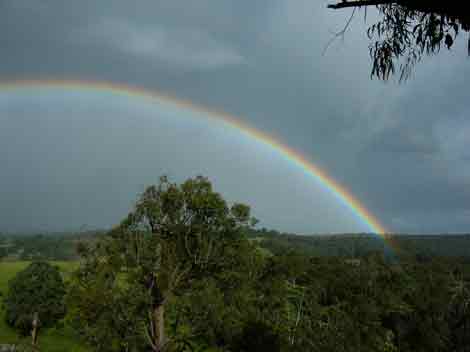
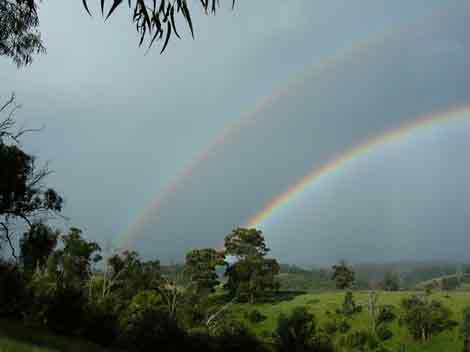
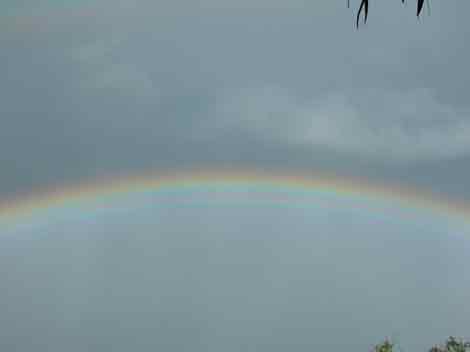
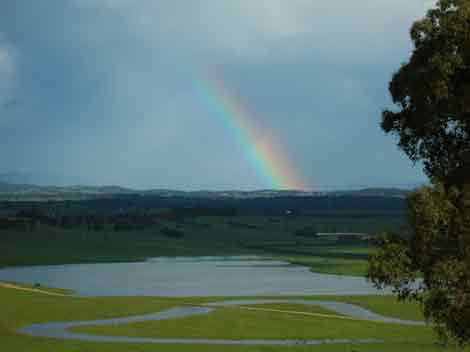
It's plain, Yarra's a stain in the rain, concedes Thwaites by Farrah Tomazin The Age January 19, 2005 p5
The State Government has conceded that the Yarra River may never be safe after heavy rain, no matter how much effort is put into fixing pollution.
Acting Premier John Thwaites said yesterday that regardless of how many litter traps were installed to curb rubbish and bacteria in the river, there would always be a risk after wet weather, when faeces, litter and decay is washed through the city's stormwater drains.
"It will not be safe after heavy rain, as long as we've got millions of people living around it," Mr Thwaites told Radio 3AW.
"With all the programs that you do, all the litter traps, there will still be litter and an element of dog poo and dead birds."
The Yarra has been under intense scrutiny in recent weeks. It has been linked to a spate of illnesses in kayakers and the unexplained deaths of 100 eels since last week.
As pressure mounted to tackle growing concerns, The Age revealed on Monday that the Government would consider a new alert system to warn the public when the river was too risky because of bacteria.
The Government is seeking the advice of the Environment Protection Authority on the plan, under which water samples could be taken from the river and warnings issued to the public when bacteria levels are too high.
Environment Victoria executive director Marcus Godhino said he supported an alert system. But monitoring water quality was not enough, he said, calling for new research to find the causes of Yarra pollution.
While the Government says the main source is dog faeces, Mr Godhino suspected that poor infrastructure, run-off from farms or not enough water in the river was also to blame.
"An alert system is something that we support because it will let people know when they can use the river. However, we need to go further: don't just monitor the water, do the research as well" he said.
The Government recently set a target to make the river safe for swimming by 2008. Mr Thwaites said authorities had advised him that this was achievable in the area upstream of Dights Falls in Collingwood, but would be difficult to achieve downstream towards Princes Bridge.
Opposition environment spokesman Phil Honeywood yesterday described Mr Thwaite's comments that the river would never be entirely safe after heavy rain as a Government backflip.
"For five years, the Bracks Government has promised to make the river safe. Only after they have been caught out are they now admitting they're not up to the job," Mr Honeywood said.
Government figures show that three kayakers contracted leptospirosis while using the river in the past three years.
One, Mark Shorter, 28, suffered delusions, lung haemorrhaging and liver failure after swallowing water while kayaking at Dights Falls last year.
Another, Mathew Dixon, 31, suffered similar symptoms after performing an eskimo-roll manoeuvre near Warrandyte in 2002.
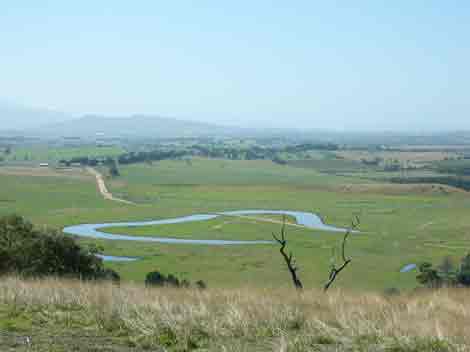
March 05: Billabong still gorged with water after November 2004 minor floods near Yering Gorge.
The Yarra's not pristine - but we're working to get it there
By John Thwaites The Age January 19, 2005 p13
It's a great river for swimming, except after storms.
Several recent incidents have led to understandable public concern about the health of Melbourne's Yarra River. The Victorian Government shares these concerns, as it continues its efforts to improve the river's quality.
He incidents involving three canoeists over four years were caused by leptospirosis, a bacterium associated with cattle urine, which has increased levels in the river after heavy rain. The Government frequently warns against swimming after heavy rain but this is, of course, exactly the time canoeists like to ride the fast-flowing waters, despite the associated risks of ingesting water. The highly elevated E.coli figures reported recently in The Age were collected shortly after the heavy rainfall at the time of last year's Melbourne Cup.
The Government has a state environment protection policy objective that people should be able to use the Yarra for recreation activities, including for swimming. However, the objective dos not include swimming after a storm. In fact, people should not swim for five days after heavy rain.
And health authorities recommend people should avoid ingesting water at all times - as for all untreated waters in creeks, rivers or the bay.
The Bracks Government has invested more than $30 million towards improving the Yarra and has seen the water quality improve recently. The water quality objectives above Dights Falls in Collingwood are generally met and the upper Yarra is safe for swimming - except after a storm.
Twenty years ago the E.coli results for the Chandler Highway monitoring site were about 1400 organisms per 100 millilitres and since 1993-94 they have dropped from about 600 organisms per 100 millilitres to about 320 organisms per 100 millilitres in 2004. The marked improvement in the water quality is largely due to removal of industry discharges and improved stormwater run-off.
However, the area around Princes Bridge in the city remains a concern due to elevated E.coli resulting from stormwater run-off in Melbourne's most highly urbanised area. There has been no cut in the Environment Protection Authority budget. The figures being deceptively quoted by the State Opposition reflect the fact that responsibility for distributing stormwater management grants to councils has shifted from the EPA to the Department of Sustainability and Environment. There has been no reduction in the ability of the EPA to monitor and enforce anti-pollution laws.
In fact, the Bracks Government has substantially increased the EPA's budget since coming to power. Since the last year of the Kennett government in 1998-99, the EPA's budget has been increased fro $27 million to more than $33 million last year.
The Bracks Government has also established a new stormwater action program - stormwater management is one of the most important ways to reduce pollution into the Yarra. About $22 million was invested in this program in the first four years of the Bracks Government and a further $10 million has been allocated as part of the Government's "Our Water Our Future" action plan.
In addition, Melbourne Water has a program for improving the Yarra, including $8 million to be spent this year. This program includes installing litter traps and wetlands along the Yarra to reduce stormwater pollution.
Victoria has not rejected $30 million in federal funding. This amount was promised by the Commonwealth Government during the election campaign to cover the whole of Australia, but so far there have been no funds allocated. However, Victoria did apply to the Federal Government for $10 million last December to match its own commitment for stormwater management programs and is yet to hear a response.
It remains a fact that water quality in the lower Yarra has been steadily improving. It remains an urban river affected by stormwater flows. But is it vastly improved from the days when The Age ran the "Give the Yarra a Go" campaign in 1990.
To help keep the community informed, I am considering a water-quality alert system similar to the EPA Beach Report.
The Government is acting to improve the health of all our rivers - including the majestic Yarra. I encourage all parties to get behind the campaign to further improve the Yarra. John Thwaites is state Environment Minister.
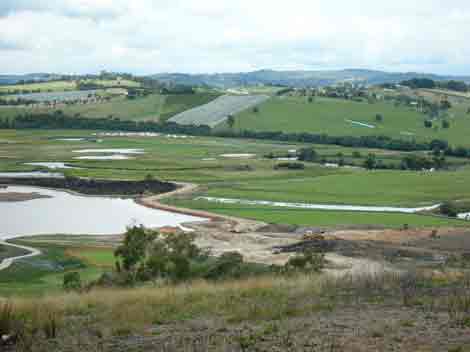
March 05: Nasty development on Henley floodplain upstream from Bend of Islands.
Yarra watchdog axed to cut costs The Age January 20, 2005 p9
The Government cut a waterways group when it was needed most, former members say.
Our Sick River by Farrah Tomazin State Political Reporter A key advisory group set up to help improve the creeks and waterways that flow into the Yarra River was disbanded last year.
The Yarra River catchment committee was a community based group set up in 1997 to develop action plans to improve the health of the land around the Yarra catchment and the quality of water that flowed into the river.
But the group - community representatives, councillors and government agency workers - was disbanded last year by the Catchment Management Authority, a statutory government body, amid claims by some members of a "cost-cutting exercise".
The State Opposition, environment groups and former members of the catchment committee yesterday criticised the decision. They said the recent deaths of more than 100 eels and a spate of illnesses among kayakers suggested that grassroots advisory groups were needed to help alleviate the river's bacteria-riddled state.
"What we were was a community watchdog for the government departments and the Government itself. It's ironic that only a few months after our fate these issues have blown up," said Whitehorse City Councillor Chris Aubrey, a former committee member.
Opposition environment spokesman Phil Honeywood also hit out at the decision, describing it as "yet another example" of the Government's failure to be transparent.
"This was meant to be an ongoing community watchdog to give feedback to government of any problems, any sewerage outfalls, any pollution, rubbish being caught in the river," Mr Honeywood said.
The Yarra River catchment committee was one of five committees established by the Catchment Management Authority. Other committees were established for Western Port, Dandenong, Maribyrnong and Werribee.
Catchment Management Authority chairman Mich Lumb rejected claims the committees had been axed to cut costs. Instead, he said, they were disbanded after they had completed the action plans for which they were set up.
Another river rower reveals illness by Farrah Tomazin The Age Newspaper January 20, 2005 p9
A Melbourne rower last year developed a severe bacterial blood infection after cutting his foot on a muddy embankment along the Yarra River.
Malvern resident Fraser Murrell was rowing near Herring Island, South Yarra, in July last year when he fell into the river.
The 45-year-old father swam with the boat to the river bank and pushed it onto a mud flat. He tried to stand up but sank navel-deep into the mud and cut his leg on an unknown object.
About one week later, Dr Murrell started coughing heavily and noticed swelling on his forearms. Tests found that he had contracted a bacterial infection of the blood vessels.
As suspicion about the river pollution intensified this week, Dr Murrell said the Government not only needed to focus on improving the water quality but on considering cleaning up the banks of the Yarra, which he described as "storehouses of bacteria".
"It is all very well to test the water in the middle of the Yarra and say that is this or that. But the points at which rowers and kayakers enter the river are hundreds of times more polluted again," said Dr Murrell, who still suffers from ear infections and a lack of strength as a result of the incident.
"The Government could go a long way by dredging and removing the mud and scum on the banks of the Yarra, which I believe to be the main bacterial storehouses."
Dr Murrell is the latest rower to reveal he contracted a serious infection after being in the much maligned river. The Age recently revealed three kayakers had suffered symptoms such as lung haemorrhaging, liver failure and bouts of delusion after using the river over the past three years.
The kayakers had contracted leptospirosis - a bacterial infection that stems from the urine of infected animals. Soon after the revelations, dozens of dead eels were found by rowers floating along the Yarra's inner city stretch.
The Environment Protection Authority has been investigating the deaths, but yesterday admitted the chances of finding the exact cause were low because many of the eels had been dead for several days before they were discovered.
But EPA chairman Mick Bourke said water quality near where the eels had been found was "quite good and contained no readily identifiable toxicants".
The Yarra's health is about more than just dog droppings By Phil Honeywood Melbourne Age January 20 2005 p15
Genuine bipartisan solutions are needed to save our river
The Yarra, Melbourne's iconic river, is clearly not healthy. Casting blame on the effects of high rainfall periods, dog droppings and urbanisation - as state Environment Minister John Thwaites did on this page yesterday - does nothing to achieve genuine solutions to the problem. A range of measures needs to be enacted quickly both for the health of the river and the people of Melbourne.
First, Melburnians have a right to timely and transparent information about the state of their river. Just as beachgoers receive daily updates from the EPA about the health of the bay, the Yarra River should be the subject of regular reports, and be accorded the same priority. Regular publication of water-quality results at all testing stations along the river would ensure a better informed community that will be more likely to act as watchdogs on litter, septic and other discharges into stormwater drains and the river itself.
Relying on the government of the day to release information only when it chooses to do so is no longer good enough. This was demonstrated only last week when Thwaites said that "there is no evidence that the Yarra is not safe".
However, this was exposed as misinformation when the next day The Age published Melbourne Water test results that indicated bacteria levels at up to 22 times safe requirements.
It beggars belief that the Minister for the Environment would not receive information such as that provided by Melbourne Water as all Government ministers' offices receive regular briefing papers and updates on sensitive community and political issues. This Government needs to be held accountable for its promise to have a safe river for swimming by 2008.
Second, pointing the finger of blame at the dog owners distracts from a comprehensive analysis of the full range of pollutants, their sources and the action required. Over recent years, there has been a significant change in the behaviour of dog owners. While some might argue that this is a result of local government regulation and enforcement, the improvement is obvious to most Melbourne residents. Go for a walk through any inner-urban park and you will witness dog droppings being scooped up by dog owners. If this does not occur, there are now many vigilant joggers and walkers who will take the animal's owner to task on their community responsibility.
The more difficult task for any Government is to track and prosecute all polluters. A large area of outer eastern Melbourne is still totally dependent on household septic tanks. Communities adjacent to the Yarra River and its feeder creeks include Warrandyte, Park Orchards and Donvale. Despite intensive lobbying over many years, successive state governments constantly push back the sewerage connection backlog program. For a city of international standing, such as Melbourne, to have thousands of households still totally reliant on septic tanks discharging into backyards is an indictment of our community's priorities.
A key concern here is that again we are receiving mixed messages about the areas of most concern along the Yarra. Thwaites maintains that the lower reaches of the river are the areas that are unsafe. Yet publication of Melbourne Water's test results by The Age highlighted that the highest E.Coli rates were registered at the Bulleen testing station. This is located much further upstream than what could be regarded as the lower reaches of the Yarra. The Bulleen water quality testing station is also the most geographically proximate to the communities that are reliant on septic tanks.
In all the debate on the Yarra River's health, this issue seems to have been overlooked.
Third, increasing urbanisation has been the other major problem identified by the State Government as the cause of river pollution. But when the Government embarks on planning policies that promote high-density living it must be willing to finance the infrastructure requirements that flow on as a direct result.
The Bracks Government provided $22.5 million over three years until June 2003 for local government to develop stormwater management plans. These grants were available to all councils across Victoria. Unfortunately, funds now available for implementing these costly management plans have been reduced to $10 million over the next three years. All funding is provided only on a matching basis - so only local councils in a sufficiently strong financial position will be able to undertake any of these stormwater infrastructure improvements.
Both the State Government and local councils have been major financial beneficiaries of the high-density urban planning policy. The Bracks Government has received windfall gains from stamp duty and land tax on inner-city apartment sales. Councils have received additional rates revenue.
The State Government also introduced a new water tax, officially called an environment levy, only six months ago. It will receive $200 million over the next four years from the new levy alone.
If the much-lauded stormwater management plans are now to be implemented, with their improved environmental drainage and litter traps, then clearly more than $10 million will be required from State Government sources.
There are many causes and effects of the Yarra River's poor state of health. However, it will only be by opening up the debate, providing transparent information and by achieving genuine bipartisan solutions that we will succeed in saving our river.
If we are to retain our reputation as a city of international standing, then a healthy Yarra River must be given priority.
The Age January 21, 2005 Letters p16
Give the Yarra enough water to flush it clean
The public debate about water quality in the Yarra River is a godsend for the Government. The focus on water quality has come just at the time that the Government is about to sign off on the bulk water allocation of water from the Yarra River to Melbourne Water.
The determination of the amount of water to be allocated under the agreement is being made in the absence of any reliable information on how much water it is appropriate to take from the river.
A planned study to determine the needs of the river is apparently still two years from completion.
Environment Minister John Thwaites (Opinion 19/1) assures readers that the Government is working on the water quality problem - but he makes no mention at all of water quantity.
Presumably he would have us believe that water quality and water quantity are unrelated. Of course, this is not the case: they are simply two aspects of the same issue.
For example, an E.coli count of 600 organisms per 100 millilitres would be reduced to 300 organisms per 100 millilitres if the quantity of water was doubled by the addition of an equal amount of water with no E.coli present. While the citizens of Melbourne get focused on the quality of the water in the river, the Government is quietly allocating water from the upper catchment as if this was not part of the solution to the water quality issue.
With this skill at dealing from the bottom of the pack, Mr Thwaites should be running a poker school.
Dr Brian Finlayson, centre for environmental applied hydrology, University of Melbourne.
Loving our Yarra means caring too
Melburnians love the Yarra but are blind to their impact on it.
We build closely along its banks; we let pollution pour into its waters untreated; we watch it become choked with disgusting rubbish every time there is a storm; we use water for drinking and other purposes with no regard for the needs of the trees, fish and birds.
The State Government's target for a swimmable river by 2008 is not backed by a management framework that will produce a real improvement in river health.
The EPA's diminishing budget surely precludes more intensive scrutiny of polluters. No single authority manages the Yarra. If you stand in the water, Melbourne Water is in charge. If you stand of the banks it's the local council, or VicRoads, or the catchment authority.
And the Department of Sustainability and Environment is not sure how much water the river needs in environmental flows because it has not done the study yet.
Livable cities need healthy, well-managed rivers. At present the Yarra is neither. Human illness and fish deaths are a wakeup call that our river is in trouble.
Natalie Jamieson, Thornbury
Sediment a threat to Yarra's fish
The Yarra is a hazard not only to human health. Spare a thought for the species that rely on the river for their survival. They include platypus and a diverse range of native fish such as the endangered Murray Cod, Macquarie Perch and Australian grayling.
The species are at risk through run-off contaminated with bacteria, pesticides and petroleum products. Another major problem for native fish in the Yarra is the amount of sediment washed into the river from stormwater drains and roadways. This can smother in stream-habitats where native fish spawn and lay their eggs.
How many building sites and developments throughout the Yarra catchment have inappropriate sediment control measures? How often does one see building sites with piles of dirt sitting in gutters and driveways ready to wash into stormwater drains when it rains?
What are local and state government agencies doing to tackle this enourmous problem? Any plan to improve the state of the Yarra, will fail unless it also acts of sedimentation problems.
Anthony Amis Friends of the Earth Melbourne.
Rivers need a stronger flow
Much of the recent focus on the poor state of the Yarra River concerns risks to human health and recreational interests. Less attention is given to the ecological health of the river system itself.
Co-ordinated action is urgently required to ensure the river and its tributaries receive meaningful environmental flows and that the banks are protected by nature vegetation ecosystems.
This will improve the health of the river and its native flora and fauna, and benefits to humans will naturally follow.
Silvana Predebon Fairfield.
Exposed: Why the Yarra is so sick by Geoff Strong and Stephen Cauchi The Age 22/1/05 p1
State Governments have known for eight years that the overwhelming source of faecal contamination of the Yarra River is human sewage, not dog excrement as acting Premier John Thwaites claimed this week.
A 1997 report by the Environment Protection Authority, Origins of Faecal Contamination in the Lower Yarra, said 60 per cent of all downstream faecal pollution was human. The canine contribution was minimal.
The EPA's study was a breakthrough in that it did not simply measure the bacteria Escherischia (E.coli); instead, it used technology developed in the early 1990s by the CSIRO to determine the origin of the faecal matter.
It is believed no follow-up study using this technology was ever conducted. The report listed the key potential sources of such contamination to be leaking sewer pipes, sewer overflows due to illegal toilet connections, illegal toilet connections to stormwater drains, particularly in older suburbs, and septic tanks mainly in the upper reaches of the river.
Despite recent alarm sparked by people falling ill after coming in contact with Yarra water - including kayakers admitted to hospital - Mr Thwaites last week blamed the bulk of the problem on people not cleaning up after their pets. "There can be up to 90 tonnes of dog poo that's washed down the river system (each year) and then into the bay, and that's the principal cause of E.coli in the river," he said.
Mr Thwaites also suggested the problem existed only at times of high water flows after heavy rain and that it was safe to swim in the river at other times.
But the 1997 report categorically refuted both these assertions. In the foreword, the EPA chairman, the late Dr Brian Robinson, acknowledged that there had been considerable speculation that dog droppings were the main source of Yarra contamination.
But, using the latest technology available at the time, the EPA found little indication of substantial faecal contamination from dogs.
"However, significant inputs of human faecal matter to the river were found in both high and low-flow events and stormwater drains were identified as an important source of this contamination," Dr Robinson said.
Mr Thwaites yesterday disputed suggestions that the report contradicted the Government. He said he had never argued that dog poo was the "number one" cause of bacteria in the river. "What I said was that dog poo and decaying organic matter, like dead birds or dead animals, or decaying trees and plants, can lead to the bacteria that's the major cause of (E.coli)," he said.
Mr Thwaites said there had been a reduction of more than 70 per cent is the number of sewerage spills - which lead to human faecal contamination in the river - since 1997 when the report was prepared.
"The 1997 situation is quite different to what it is today and millions of dollars have been invested to achieve this improvement," Mr Thwaites said.
The Government's woes over the Yarra intensified yesterday with claims it had reaped tens of millions of dollars from a water authority charged with fixing sewerage seepage.
Figures released by the Opposition suggest the Government was paid more than $100 million in dividends over the past two years by Yarra Valley Water, while $10 million was used by the authority over the same period to fix sewerage backlogs in Melbourne's outer east.
Opposition environment spokesman Phil Honeywood said the figures were a disgrace. "If the Bracks Government continues to move at a snail's pace to hook up houses to sewerage and spends a measely $5 million a year - it will take 40 years to stop human effluent from contaminating our Yarra River," Mr Honeywood said.
But the Government defended the dividends, saying the money was used to improve services and infrastructure, including water infrastructure. He Environment Protection Authority's director of water and national programs, Chris Bell, admitted yesterday that some surges of bacteria in the river could not be explained by heavy rainfall.
"We have occasional spikes that are reflected in rainfall . . . but even if you segregate the data we still do get some high results. Those are the ones that we need to chase because there's no obvious reason for it," he said. "Even if you take out those high-flow (stormwater) data . . . you still have a need to reflect those high results that might be due to other causes."
Data obtained by The Age last week showed the lower Yarra was heavily polluted with bacteria. The monitoring station at Princes Bridge measured levels 22 times the accepted standard for swimming in November.
But figures obtained yesterday showed that the upstream Yarra is also bacteria-ridden. The monitoring station at the Chandler Highway in Kew - the only such station between Princes Bridge and Warrandyte - showed that average levels of E.coli in 2004 were 381, well over the EPA standard for swimming.
Melbourne Water does not measure other bactera, as E.coli is considered a representative "indicator" of other organisms in the water.
However, Mr Bell said yesterday that peaks in bacteria, such as those caused by heavy rain, "skewed" the yearly average. A mathematical equation - a geometric mean - was used instead, he said, as it smoothed out fluctuations. A simple average, consisting of adding the 12 monthly figures together and dividing by 12, was not "scientifically accurate", he said.
The peak E.coli figures at Kew were 3000 in February and November and 2300 in September. However, figures released by Melbourne Water showed that E.coli figures in the Yarra had declined marginally over the past 30 years. Comparison is difficult because of missing statistics and enourmous yearly fluctuations in the amount of measured E.coli, but both the Princes Bridge and Chandler Highway are generally recording a lower bacteria level in the past five years than in the 1990s and 1980s.
The EPA's 1997 study was able to determine that after humans the next biggest contributor was faeces from livestock, particularly in Merri Creek where Dr Robinson said upstream run-off from rural areas used for grazing was the likely source.
It is believed that no subsequent study of Yarra water has been done using this species-specific method, instead simply measuring E.coli contamination. This is despite refinements of the species-specific biological market technology.
The 1990s breakthrough allowed scientists to identify biomarkers for some species, mainly humans and herbivores. In humans it is a chemical called coprostanol, produced in the gut by bacteria breaking down cholesterol. It is found in small quantities in pigs and cats but not in dogs.
At the time of the study no biomarker was available for dogs but one has since been developed. Yesterday the EPA's director of environmental science, Dennis Monahan, played down the 1997 report saying:
The most reasonable conclusion is . . . that faecal contamination is due to a range of sources, including humans, dogs, sheep, cattle, birds and possums. "While the report identified the presence of contamination from humans since 1995, there has been considerable investment by water companies in improving sewer infrastructure and providing services to septic tank areas." With Farrah Tomazin.
The Kayaker Yarra water claims another victim The Age January 22 2005 P 5
Yet another kayaker - the fourth so far - has reported feeling ill after accidently swallowing Yarra water.
Maya Brener, 22, of Melbourne, went out on the river last February on a hired kayak for what turned out to be a disastrous day. Ms Brener set out from the Fairfield Boat Shed and went upstream for about an hour before heading back downstream.
One of the skills she practised was an "eskimo roll", designed to right a kayak that has capsized and forced the rower underwater.
"I was doing that at the end and just practising tham a bit and at one point I stuffed one of them up and swallowed a little bit of water," she said.
It wasn't until she had packed up and gone home that she began feeling "really, really sick". "My face went really pale and I broke out into a sweat and pretty much from that point for the next two days I was just vomiting a lot and I was pretty much completely out of action."
Ms Brener said she did not go to the doctor as she recovered after two days. "I recovered after that, but I only swallowed a really small amount of water. It was a concern to me that I swallowed a really small amount and got that sick from it," she said.
She said she has not been back to the river since. "My whole body and my wetsuit smelt really awful from the water." Ms Brener said she had practised the eskimo roll in other rivers, swallowed the water, and not gotten sick. But the Yarra's water was not fit for it, she said.
Ms Brener's experience was mild compared to that of Mark Shorter, 28, whose illness first drew renewed attention to the state of the Yarra. Mr Shorter suffered jaundice, delusions and liver failure and was in intensive care for two weeks.
He fell in the river last November while kayaking near Dights Falls, downstream from where Ms Brener did her eskimo roll. Stephen Cauchi
The Dog Walker - Pooper-scoopers are not the only solution The Age January 22 2005
Dog owners are being unfairly blamed by the State Government for pollution levels in the Yarra River, says one owner who regularly walks his dogs along the Yarra and Merri Creek.
Brunswick resident Bon Krunic carries plastic bags to pick up waste when he walks his two dogs, Jac and Kate. "If there were more bags supplied (by councils) in designated dog walking areas, it might motivate more people to do the right thing," he said.
Mr Krunic stressed the real problem was rubbish, not dog poo, collecting along the river. "It isn't enjoyable for the dogs, let alone the dog owners," he said. "If the councils did more, there'd be less rubbish and less pollution in the river."
Acting Premier John Thwaites this week blamed dog faeces as a factor in polluting the Yarra, saying heavy rain washes it and other litter into the city's stormwater drains. According to the Victorian Litter Action Alliance, dog waste contains harmful bacteria that can wash into waterways. Melbourne City Council and the inner city councils of Yarra, Darebin and Boroondarra have strategies to limit the amount that ends up in the Yarra.
Melbourne Council provides an information kit to all dog owners upon registration. It contains a pooch pouch and 10 waste disposal bags.
Yarra Council is running a summer campaign to educate dog walkers around dights Falls - upstream on the Yarra - about cleaning up after their dogs. Mayor Kay Meadows said the city fined owners $200 for not picking up after their dog or not carrying a bag or pooper scooper to pick up the mess.
Boroondarra will embark on a new strategy early this year, including a program to encourage the removal of dog waste from all public open spaces.
Darebin's environment and amenity manager, Libby Hynes, said there were "greater contributors to the quality of stormwater, including sewage and litter". Martin Boulton.
Yarra's a cesspool, tests show Samples collected for The Age reveal human source behind river pollution By Stephen Cauchi Science Reporter The Age March 5, 2005 p1
Independent testing commissioned by The Age has revealed the Yarra from the city to Kew is infested with a host of bacteria that can cause severe illness if swallowed.
The results point to pollution from human as well as animal faeces, with levels of many pathogens breaching local and international standards for recreational water.
The testing revealed that the most polluted site is the entry point of the Prahan main drain into the river near Melbourne High, indicating that illegal sewerage connections are a chief source of the bugs in the water - bugs that include illness-inducing enterococcus, campylobacter and salmonella.
The tests also showed that while E.coli counts - the only bacteria officially tested by Melbourne Water - indicated that the upper stretch of the river was acceptable for recreational use, the alternative enterococcus indicator showed the entire stretch easily breached the Australian standard.
The State Government has upgraded its monitoring program of the Yarra after recent reports by The Age on the river's health and ahead of this month's Moomba festivities, which include waterskiing and the tradtional Birdman plunge off the Princes Bridge.
This year, Birdman competitors will be hosed down with fresh water on getting out of the river, given mouthwash and monitored by St John Ambulance officers.
The Age commissioned the CSIRO, Australia's public science agency, to collect samples of water at five sites along the river from the city to Kew. The samples were taken to the Australian Water Quality Centre in Adelaide for testing.
Samples were taken at Princes Bridge in the city, the South Yarra rail bridge, the Heylington rail bridge in Toorak, Dights Falls in Collingwood and the Chandler highway in Kew.
Melbourne Water tests only at Princes Bridge and Kew, although it recently announced it would increase the number of testing sites. Counts of the faecal germ E.coli were three times the acceptable minimum (200 organisms per 100 millilitres) in the city and South Yarra, but within the minimum at the other sites.
However, The Age sampling showed there was little correlation between E.coli levels and those of the other bacteria. The Age tested for 10 pathogens and viruses, including E.coli, enterococcus, coliforms, faecal streptococci, campylobacter, salmonella, clostridia, hepatitis A and novovirus.
Most of the bugs can cause severe gastrointestinal illness.
The tests also showed:
*Counts of enterococcus easily breached the Australian standard (35 organisms per 100 millilitres at all sites and were more than five times the acceptable level at the Chandler Highway.
*There is no local standard for total coliforms, but the figures at Dights Falls and the Chandler Highway breached the legal minimums set by the European community.
*The levels of fecal streptococci at Princes Bridge and Chandler Highway breached the recommended European standard for swimming water.
*Salmonella was detected at Dights Falls and the South Yarra rail bridge, but not at the other sites. Similarly, a high campylobacter count was recorded at the Heyington rail bridge, but not at other sites.
*No hepatitis A or novovirus was detected at any site, but sulphite reducing clostridia, and clostridium perfringens were detected at all sites. The samples were collected at Collingwood and Kew on February 14 and on February 21 at the other sites.
In accordance with Melbourne Water guidelines, there had been neglible or no rain in the five days before sampling. The samples were gathered well after the record breaking storm of February 2, which would have sent bacteria levels soaring as animal faeces and other waste washed into the river.
Melbourne Water's own figures showed E.coli counts of 22, 13 and seven times the minimum level during their monthly counts at Princes Bridge last year. Its rain-free "base rate" for E.coli at Princes Bridge in 2004 was 542, close to The Age figure of 550. The safe level for swimming is 200.
Melbourne Water and the Environment Protection Authority do not test for pathogens other than E.coli, citing cost and the fact that E.coli is a good indicator of faecal contamination.
Dr Chris Walsh from Monash University's urban water ecology group said the results showed that "problem drains" remained the cause of the Yarra's ills. "Certainly one that's quite well known to be a problem is the Prahan main drain that comes out under Melbourne High," he said. "That would be my first suspect for sure. I think it's known there's definately illegal sewerage connections to the stormwater system up there in that catchment and the Prahan-South Yarra area. I think that Melbourne Water has spent years trying to track down that sort of stuff."
The Age approached a number of Victorian testing agencies to do the collecting and testing, but all refused - some citing business dealings with the State Government. They also refused to comment on findings...
The river, according to Melbourne Water data, also failed to reach acceptable levels for the industrial pollutants lead and nitrogen.
EPA chairman Mick Bourke said it was acceptable to test only for E.coli as it was a "World Health Organisation credentialled and recognised indicator for faecal contamination". "EPA Victoria's monitoring programs require consistent assessment of faecal contamination in rivers and streams. The world-accepted and most practical way to do this is e.coli," he said. "E.coli is robust and reliable as an indicator for this type of contamination in fresh water. It has the added benefit of providing speedy evidence on water quality, when considering the suitability of rivers and streams for various recreational activities."
Last week Victorian Environment Minister John Thwaites announced an upgraded monitoring program for the Yarra. The number of testing sites would be increased, with weekly testing throughout the year. A weekly Yarra Watch report would assess the health of each stretch of the river.
A "hot spot blitz" would test 50 sites over the next year to identify sources of pollution.
How safe is our water?
Camylobacter, Salmonella, Sulphate Reducing Clostridia (including Clostridium Perfringens)
Found in human and animal faeces. Causes gastro symptoms, including diarrhoea, stomach cramps, fever and nausea.
Coliforms
Bacteria found in human and animal faeces and from vegetation; they indicate the presence of disease-causing bacteria. European minimum standard for recreational water use is 10,000 per 100ml. E.coli Bacteria found in human and animal intestines, strains of which can cause serious illness. Australian minimum safe standard is 200 per 100ml.
Faecal
Streptococci Indicator bacteria found in both human and animal faeces that can persist in water for an extended period. European recommended standard is 100 per 100ml.
Enterococcus
Bacteria normally found in the bowel and the female genito-urinary tract. They may cause urinary tract infections and other infections. Australian minimum standard is 35 per 100ml.
Princes Bridge Organisms per 100ml E.coli 550 Coliforms 8200 Enterococcus 120 Faecal streptococci 120 Campylobacter 3.6 Also Present: Sulphite-reducing clostridia, clostridium perfingens. What it means: The E.coli reading here is about the same as the Melbourne Water average for this site last year - 542. The safe level is 200. Enterococcus was well over the minimum (35) at all sites; here it is 120.
Near Melbourne High School Organisms per 100ml E.coli 580 Coliforms 7400 Enterococcus 94 Faecal streptococci 94 Campylobacter 1.5 Also Present: Salmonella, Sulphite-reducing clostridia, clostridium perfingens. What it means: This site, downstream of the Prahan main drain, recorded the highest levels of E.coli and sulphite-reducing clostridia (including clostridium perfringens) for all five sites. It was also one of only two sites where salmonella was detected.
Heyington Rail Bridge Organisms per 100ml E.coli 140 Coliforms 6000 Enterococcus 95 Faecal streptococci 95 Campylobacter 46 Also Present: Sulphite-reducing clostridia, clostridium perfingens. What it means: If you go by the low E.coli reading, 140, the river here is within Australian guidelines for recreational water use. But the same guidelines recommend an enterococcus figure recorded here is more than twice that. As well, Heyington recorded by far the highest campylobacter reading - 46 per 100ml.
Dights Falls Organisms per 100ml E.coli 170 Coliforms 11000 Enterococcus 86 Faecal streptococci 86 Campylobacter 4.3 Also Present: Salmonella, Sulphite-reducing clostridia, clostridium perfingens. What it means: An acceptable E.coli reading of 170, but this site recorded the equal highest coliforms figure and was the only other site where salmonella was detected. Although the enterococcus figure of 86 was the lowest of the five sites, it is well above the minimum figure of 35.
Chandler Highway Organisms per 100ml E.coli 170 Coliforms 11000 Enterococcus 190 Faecal streptococci 190 Campylobacter 4.3 Also Present: Sulphite-reducing clostridia, clostridium perfingens. What it means: This is the only other site on the lower Yarra, apart from Princes Bridge, that has been tested by Melbourne Water. The E.coli figure is within guidelines and matches the average official figure. But the coliforms figure was the equal highest. The enterococcus reading of 190 was the highest recorded at the sites and over five times the acceptable limit.
Yarra's E coli levels soar by Sarah Wotherspoon Herald Sun p14 July 31, 2005
Thousands of E coli organisms are flowing into the Yarra River, pushing the number of bacteria up to 70 times higher than the recommended safe level.
Only one testing site along the river between Millgrove and the city in the latest survey had an average reading below the safe level.
Data released by Melbourne Water this month showed the highest reading in the Yarra was at Warrandyte, with 14,000 E coli organisms per 100ml.
The recommended safe level for swimming and other water sports is 200 organisms per 100ml.
The report titled Summary of Waterway Water Quality Data 2005 showed that the Yarra at Princes Bridge averaged 600 organisms per 100ml, a 25 per cent increase from 2004, with a maximum reading of 4000.
More than 20 testing sites in the Yarra catchment had average readings over the recommended safe level.
Three streams in the Yarra catchment - Jumping Creek, Koonung Creek and Plenty River - had the highest single E coli readings of 30,000 organisms/100ml.
The highest overall E coli reading was 170,000 organisms in Stony Creek, Yarraville, which is part of the Maribyrnong catchment.
Opposition environment spokesman David Davis said the Government had allowed Melbourne's rivers to turn into sewers.
"After seven years the Bracks Government must assume responsibility for its failure to clean up Melbourne's rivers," he said.
"The statement by John Thwaites that the river could not be cleaned up stands in contrast with the achievements of cities internationally, and no Victorian thinks that's good enough."
But a spokesman for Environment Minister John Thwaites said the Government had committed a lot of money and resources to cleaning up the river.
"The figures were consistent with fluctuations that occur after rain, given the impact of a major city on storm water that runs into the river.
"This month we announced a new pollution strike force for the Yarra, consisting of a dedicated team that will find and eliminate sources of pollution and penalise polluters."
Yarra flows plan doesn't hold water - yet Drought restrictions delay start of environmental flushes By Liz Minchin 6/11/06 p4
Plans to improve the health of the Yarra by flushing 17 billion litres of water down the stressed river each year are likely to be delayed.
In April, the State Government promised to deliver minimum recommended environment flows down the Yarra by storing water in the Upper Yarra dam and releasing it in bursts through the year.
But by last month, when its Central Region Sustainable Water Strategy was finalised, the timing of the promised flows - due to start next July - was made conditional on water restrictions not becoming more severe.
With stage-two water restrictions now in place in Melbourne, and forecasts of a hot, dry summer, The Age has confirmed that the environmental flows are likely to be stalled.
"If re-elected, a Bracks government would honour its commitment to returning those environmental flows to the Yarra River from July 2007 to July 2008, but we would look at the timing of those flows if we remain on water restrictions," a spokesman for Water Minister John Thwaites said. "Yes, they may be delayed. But they will go ahead."
Environmental groups were dismayed by the news, saying the flows were long overdue.
"The Yarra has been rated one of Victoria's most stressed rivers, so it really needs those environmental flows. The longer they're delayed, the longer it delays the recovery of the river," said Environment Victoria's healthy river campaigner, Dr Paul Sinclair.
"Without these flows we will continue to see more blue-green algal blooms and more fish kills ...And we also have to bear in mind that the 17 Gigalitres the State Government has promised is still only the absolute bare minimum of what was recommended."
A Spokesman for community group the Yarra Riverkeeper Association, Ian Penrose, said the Government's decision to guarantee minimum flows was a step in the right direction and it was "disappointing it looks like being put off".
"We know the drought is affecting everybody, but that shouldn't mean that the river is forgotten or treated as a second class citizen," Mr Penrose said.
"The Yarra is such an important part of life in Melbourne and it's really suffering right now.
"Future Melbournians won't thank us if we don't do everything we can to look after it."
This week the Yarra Riverkeepers plan to survey all candidates standing in electorates that the Yarra runs through.
Greens water spokesman Louis Delacretaz said the Yarra had been running with inadequate water levels for long enough.
"If the Government focused more on reducing water wastage, they should be able to guarantee the environmental flows go ahead of time," he said.
A little arsenic with your eel? Warning to limit intake of Yarra and Maribyrnong fish by Clay Lucas Age p10 24/1/07
Fish caught in Mlebourne's Yarra and Maribyrnong rivers should not be eaten more than once a week, according to the Victorian Environment Protection Authority.
Two new EPA studies into the safety of fish and eels from Melbourne's two main rivers found traces of mercury, arsenic, pesticides, hydrocarbons and dioxins.
But the EPA said the level of contaminants found in 252 fish caught between April and May last year were not dangerously high.
It is recommended that fish from the Yarra or Maribyrnong should be eaten once only a week, and once only a month by children.
Adults brave enough to eat eels from the Yarra or Maribyrnong should restrict themselves to one serving a month, while children and pregnant women should never eat eels caught in the rivers.
"This is a very cautious study," said EPA chairman Mick Bourke.
He confirmed that deadly polychlorinated biphenyls or PCBs - a chemical used to make plastic until the 1980s - had been found in low levels in all fish. But they were very safe levels, he said.
"Compared to somewhere like Botany Bay in Sydney (these results) are pretty good," he said.
Toxicologists from the Victorian Department of Human Services who sat on the study panel said fish from either river should not be eaten too regularly.
The study looked at black bream, mullet, mulloway and eel caught in the Yarra and Maribyrnong. The reports totalled 372 pages of extremely technical data.
State upper house MP Colleen Hartland, the Greens' toxic-waste spokeswoman and a former Maribyrnong councillor, said the reports on the safety of fish caught in the river were "so confusing to the average reader as to be absolutely useless".
Ms Hartland last year resigned from the EPA advisory group compiling the reports because of what she called a lack of transparency.
The studies of the two waterways also looked at contamination in the lower Maribyrnong River, around a former industrial precinct in Whitehall Street, Yarraville, now owned by Port of Melbourne Corporation.
It found high levels of contamination, including arsenic.
The studies follow reports in The Age in 2005 that revealed high levels of arsenic were leaching into the lower Maribyrnong from land owned by Port of Melbourne Corporation.
Port of Melbourne spokesman Peter Harry said a cleanup operation of the contaminated site was continuing.
"Given the long industrial history of the site, it is a complex clean-up operation but we are making steady progress, which the EPA has noted," Mr Harry said.
Fill your glasses ... with the Yarra River Jason Dowling State Politics February 25, 2007 p4
MELBOURNE could soon be drinking Yarra River water from the heart of the city as the State Government scrambles to boost the city's dwindling water supplies.
The Government is undertaking a feasibility study to determine whether after-storms water can be taken from Dights Falls in Abbotsford, treated and added to Melbourne's water supply.
The Environment Protection Authority has warned the river water is unsuitable for drinking, and last month the Department of Human Services warned people not to eat more than one serve of fish a week from the river because of industrial pollution.
The Department of Sustainability and Environment plans to complete the feasibility study into the use of the stormwater at Dights Falls by the end of the year and, if approved, Melburnians could be drinking the water by 2009.
Opposition Leader Ted Baillieu said the water at Dights Falls was of poor quality.
"It's low-quality water in that area, which is close to where there has been contamination issues," he said yesterday.
"This is a symbol of the failure of the Government to plan for water reserves, a symbol of the panic that has now set in in the Labor party."
Government spokesman Craig Rowston said about two-thirds of Melbourne's water already came from the Yarra and the harvesting of stormwater had been under consideration for some time.
"As part of our central region water strategy released in October 2006, we committed to a feasibility study of desalination and stormwater harvesting," he said. "Harvesting is not new. It was being discussed as far back as late 2005 in Parliament."
Under the Yarra proposal, water would be extracted from upstream of Dights Falls, an area deemed unsuitable for swimming by the EPA because of high E.coli levels.
E.coli occurs in faecal waste and is used to indicate the presence of other disease-causing micro-organisms that pose a health risk to humans.
Melbourne Water currently takes water from the Yarra River at Yering Gorge, more than 30 kilometres upstream of Dights Falls. If the Dights Falls stormwater plan was found to be feasible, the water would be transferred to Sugarloaf or Yan Yean Reservoir and be mixed with stored river and reservoir water before being treated and released into Melbourne's drinking system.
The plan for using Yarra River water comes as Melbourne's water storages continue to fall.
The storages last week were at 34.7 per cent capacity, 19.6 per cent lower than at the same time last year and nearing the 29.3 per cent trigger for stage 4 water restrictions, which would end the watering of gardens.
Water Minister John Thwaites has said Melbourne will move to stage 4 restrictions when the trigger is reached.
Stormwater collected at Dights Falls would need to be carefully treated before it was added to Melbourne's water supply. The EPA warned that water in the Yarra is at its most polluted after heavy rains.
Mystery oil slick highlights sick Yarra
Rachel Kleinman June 15, 2007
THE source of an oil slick on the Yarra River is eluding authorities, despite the launch yesterday of door-to-door investigations to find the culprit.
The river's health has come under renewed scrutiny before a forum today on water quality in the Yarra.
EPA Victoria spokesman Bruce Dawson said scientists had identified lubricating oil in the slick, which covered a "significant stretch of the river" from Abbotsford to Kew.
Monash academic Chris Walsh said yesterday that stormwater was the greatest threat to the river's health.
The Yarra River Action Plan, launched by the State Government 18 months ago, earmarked $250 million to deal with contamination from leaking septic tanks and $20 million to target stormwater pollution.
"Stormwater run-off is Ö a more important source of faecal contamination, and other insults, than septic tanks," Dr Walsh said.
In 2005, an investigation by The Age revealed widespread pollution in the river, including high E.coli levels.
Recent EPA monitoring found poor water quality at several city sites.
Dr Walsh said stormwater contained "a cocktail of polluting substances", including cigarette butts and chemicals.
An increase in the number of household rainwater tanks would supplement supplies, and also reduce the volume of water that ended up as stormwater in the river, he said.
He will present his research today at a forum run by the Port Phillip and Westernport Catchment Management Authority. www.ppwcma.vic.gov.au/
www.waterkeepers.org.au/yarra/
Chemicals Threaten Yarra by Simon Kidd p5 Melbourne Times Nov 21, 2007

(above) Site location in relation to the Yarra
Toxic chemicals are seeping into a stormwater pipe that empties into the Yarra River, the latest environmental report into Burnley's pollution reveal.
The October audit by consultants Lane Piper of CitiPower's Madden Grove land revealed the presence of several toxic compounds including naphthalene, benzene and coal tar in soil and groundwater.
The audit also showed a black tarlike substance had infiltrated the major stormwater drain that runs through the site into the Yarra 150 metres away. The chemicals could filter into the river through the water table.
The consultants were not able to say whether chemicals were entering the river but said there was an "unacceptable risk" of them doing so.
They recommended installing lining through the pipe to prevent further seepage but said a wholesale excavation of the entire site was "unfeasible".
In a release this week, the Environment Protection Authority (EPA) said its test had not found evidence pollution had entered the Yarra from the drain.
The CitiPower site is next to Yarra Council's Burnley Depot and Metropolitan Fire Brigade's (MFB) training complex site.
In 2006, the EPA ordered the MFB to clean up its land. That project, which cost $11 million, required the brigade to remove about 100 metres of the same stormwater pipe because it was extensively contaminated.
In April, the EPA also issued a clean-up notice to CitiPower.
TMT reported last week that an EPA-ordered audit of Yarra's depot land had also revealed that site, once a landfill, was contaminated with heavy metals, tar and arsenic.
Bruce Dawson, the EPA's executive director of regional services, said the EPA had appointed a co-ordinator to oversee the clean-up of the three sites.
A Citipower spokesman declined to comment.
Yarra slick penalty Age 6/12/07
Packaging company Amcor has pleaded guilty to causing an oil slick that blighted eight kilometres of the Yarra River.
The Heidelberg Magistrates Court heard that the pollution occurred in June when contractors pumped oil into an unmarked drain, which led ultimately to the Yarra River.
Amcor, which runs the Fairfield paper mill in Melbourne's inner north, was ordered to pay $80,000 towards a drain-labelling project, revegetation and education programs. It will also pay $14,000 for clean-up costs and $10,000 in costs to the Environment Protection Authority

Yarra River (above) with Amcor's Fairfield mill highlighted in yellow
Packaging Company forced to pay $100,000 for Yarra oil spill - Melbourne Times Dec 12, 2007
Amcor Packaging was fined more than $100,000 last week after its contractors unwittingly pumped oil into the Yarra River.
The Alphington company's plant, near the corner of Chandler Highway and Heidelberg Road, discharged an oil-water mix that covered an eight-kilometre stretch of the river from above Fairfield Boathouse to past Gipps Street Bridge in Abbotsford for two weeks in June.
Heidelberg Magistrates' Court was told the paper manufacturing company ordered contractors to pump out a contained liquid area after a piece of processing equipment cracked, sending condensate into an oil drainage line, which then flowed into an oil storage tank. The tank overflowed, so contractors pumped the liquid into 44-gallon drums.
When the drums filled, the contractors pumped the liquid into an unmarked drain on the site, which led to a stormwater drain and into the Yarra.
The court was told neither Amcor nor the contractors knew the drain led to the stormwater drainage system that discharged into the Yarra.
EPA spokeswoman Ruth Ward said people canoeing on the river were first to notice the spill, with several finding their kayaks had become coated in oil.
Amcor pleaded guilty to water pollution and was ordered to pay a fine of $80,000 to the Darebin Creek Management Committee and the South Alphington and Fairfield Civic Asociation, and fines of $14,641 to Melbourne Water and $10,000 to the EPA.
Magistrate Denise O'Reilly also ordered the company to identify the location and discharge points of all the drains on its site, to mark all stormwater drains clearly and to block any drains within buildings to prevent further polluted discharges into the Yarra.
Don't let Yarra River levels hit rock bottom by Doug Hendrie Melbourne Times Jan 23, 2008
The Yarra River's low flows have produced the clearest water in years, but advocates have warned of an environmental disaster if levels drop further.
Yarra Riverkeeper Ian Penrose said the State Government decision late last year to delay environmental flows could lead to the mass deaths of fish, potentially threatening the only remaining healthy population of Macquarie Perch in Victoria.
In 2006, the Government allocated extra water to maintain the health of the ecosystems in the Yarra, but these environmental flows were deferred last April.
In November, Environment Minister Gavin Jennings announced environmental flows would be cut by 10 gigalitres a year to allow use of Yarra water as a supplement to Melbourne's supplies, but guaranteed a minimum flow of 200 megalitres a day, a drop of 45 megalitres a day from the previous minimum.
Last Thursday, the river was flowing at an average of 172 megalitres a day in Warrandyte and 191 megalitres a day in Templestowe, both below the Government minimum at which extra pumping from the Yarra at Yering Gorge must be frozen.
Mr Penrose said the river was being "sacrificed" for domestic and farm use at the expense of the environment.
"The river is incredibly low, and that means warmer water, less ability for fish to move and lower oxygen levels," he said. "A potential algal bloom could be disastrous.
"The current situation is certainly not natural - it's due to the fact we are still taking a lot of water from the river."
Melbourne Water spokesman Ben Pratt said monitoring had been stepped up.
"We have a contingency plan in place that enables us to act quickly to deal with any emerging environmental issues," he said. "This might include flushing flows down the river."
Mr Pratt said farmers and golf clubs with a licence to extract water from the river were still able to do so, but might experience bans later this summer.
Upper Yarra River & Gold Mining
For information about mining in the Thomson Catchment see here

Goldfields in the Yarra River catchment according to Victorian Department of Energy & Minerals 1993
According to "In Search of Gold", gold was sourced from the Upper Yarra by using hydraulic sluicing, which moved large volumes of dirt by playing a jet of water on them. It is also likely that mercury was used at many of these sites as a means of seperating the gold from rock particles. (please note there was also gold discoveries at Warrandyte and the Kangaroo Ground areas). Much of the mercury remains to this day, particularly at old mine batteries.
The Upper Yarra Gold Field started in September 1859, with Brittania Field opening shortly after. By November 1859 at least 200 diggers were working around Brittania Creek near the futureWarburton. Other fields started in the Upper Yarra catchment at this time included Scotchmans Creek, Hoddles Creek and Station Creek. The first rush occurred in February 1860 at Yankee Jims Creek. Soon after about 500 diggers were working the Upper Yarra. Gold was also found at Big Pats Creek, Starvation Creek, Wombat Creek, Walshes Creek and Donovans Creek in 1862. Cronins Creek and McMahons Creek opened up in 1867 and the Reefton area yielded much gold. Armstrong Creek reef was discovered in 1874 and by 1875 a water-wheel race and battery had been constructed at Reefton.
The Yarra Yarra Hydraulic Gold Mining Company was formed at Yankee Jim's Creek (near current day Wesburn and Millgrove) in the 1870's. This company worked over previously mined areas by sluicing. By 1876 a 12km long water-race had been built which used 2300 litres of water a minute when it was sluicing. "The best washdirt varying in thickness from about 20 to 75 centimetres lay on the granite bed under about 10 metres of soil and clay. This soil and clay was itself gold-bearing, to a lesser extent, from a depth of about 3 metres. The bed of the creek was about 5 metres lower than the general level of the washdirt, so the surplus dirt could simply be sluiced into the creek and washed downstream."
Hydraulic sluices also operated at Starvation Creek and upstream of Starvation Creek in the Yarra River itself.
By 1876 six companies were tunnelling at Reefton and a new water race was being constructed at Muddy Creek. By 1879 over 1700 people were living in the Reefton-McMahons Creek region. Hoddles Creek mining field started approximately in 1860 and continued in some form or other until the mid 1900's.